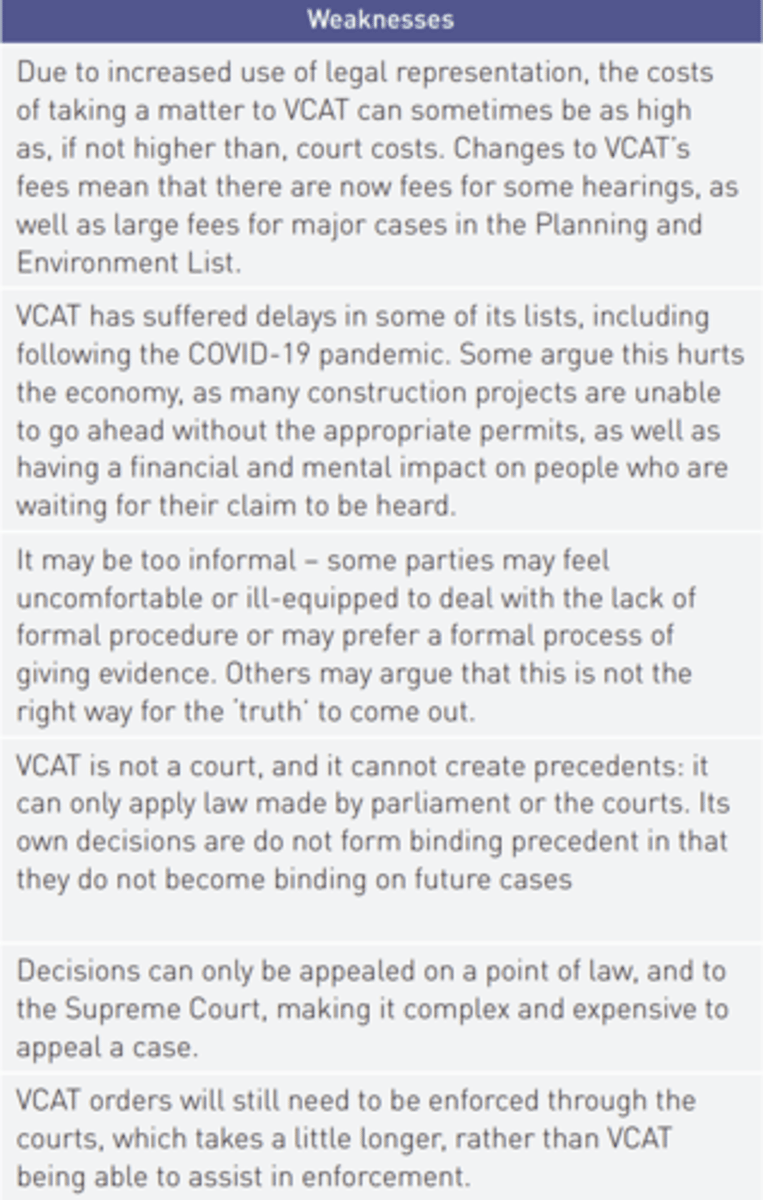Legal Studies - Unit 3 AOS 2
1/125
There's no tags or description
Looks like no tags are added yet.
Name | Mastery | Learn | Test | Matching | Spaced |
|---|
No study sessions yet.
126 Terms
Plaintiff
The one who initiates the lawsuit (sues the defendant).
Alleges their rights have been infringed.
Defendant
Alleged to have infringed on rights of plaintiff
Types of civil disputes
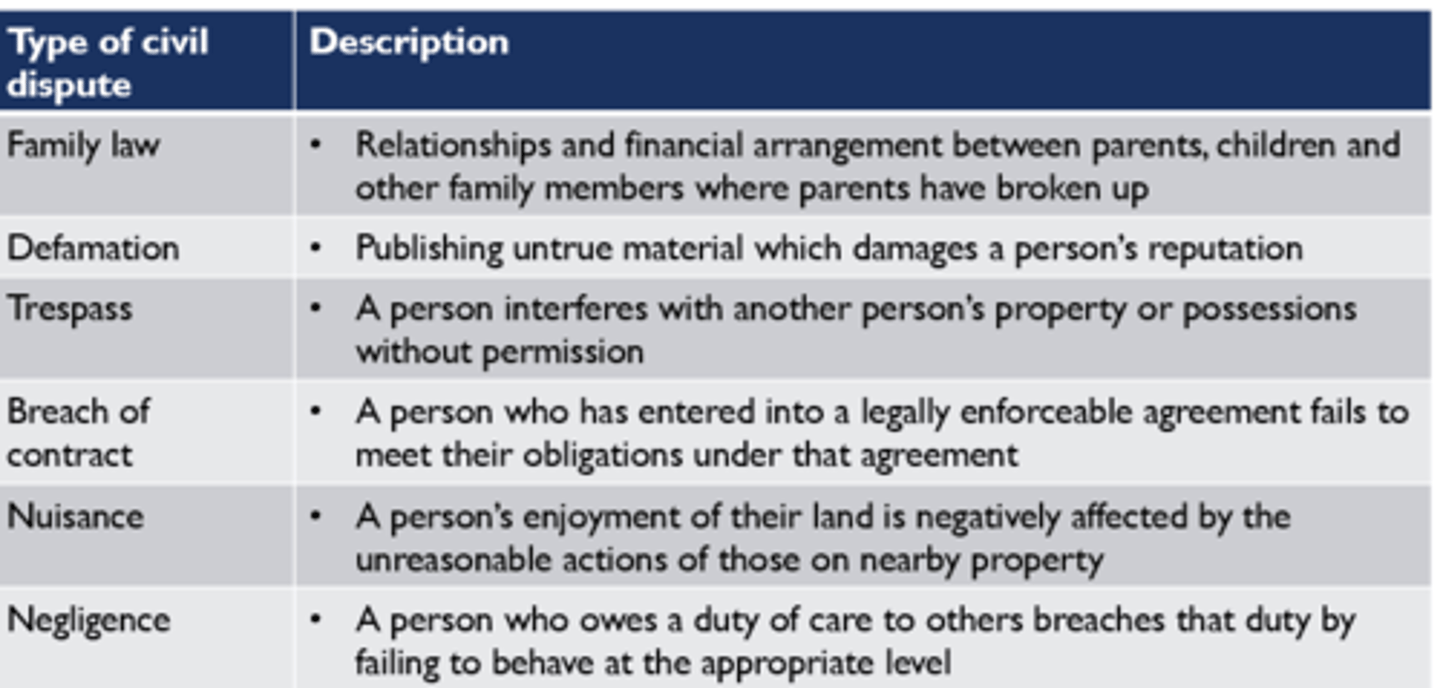
Dispute resolution bodies
Main types of dispute resolution bodies are:
- complaint bodies such as CAV (Consumer Affairs Victoria)
- Ombudsmen, such as the Public Transport Ombudsman
- Tribunals, such as VCAT
- Courts, both Victorian (such as the Magistrates' Court) and federal (such as the Federal Court)
Process of a civil claim

Burden of proof
Refers to the responsibility the plaintiff has to present the necessary facts (evidence) to establish the case against the defendant. It is fair the party making the allegation has the task of establishing liability.
It would be unfair to ask the defendant to defend themselves prior to evidence of the claims made against them being brough public and harm being demonstrated through such evidence.
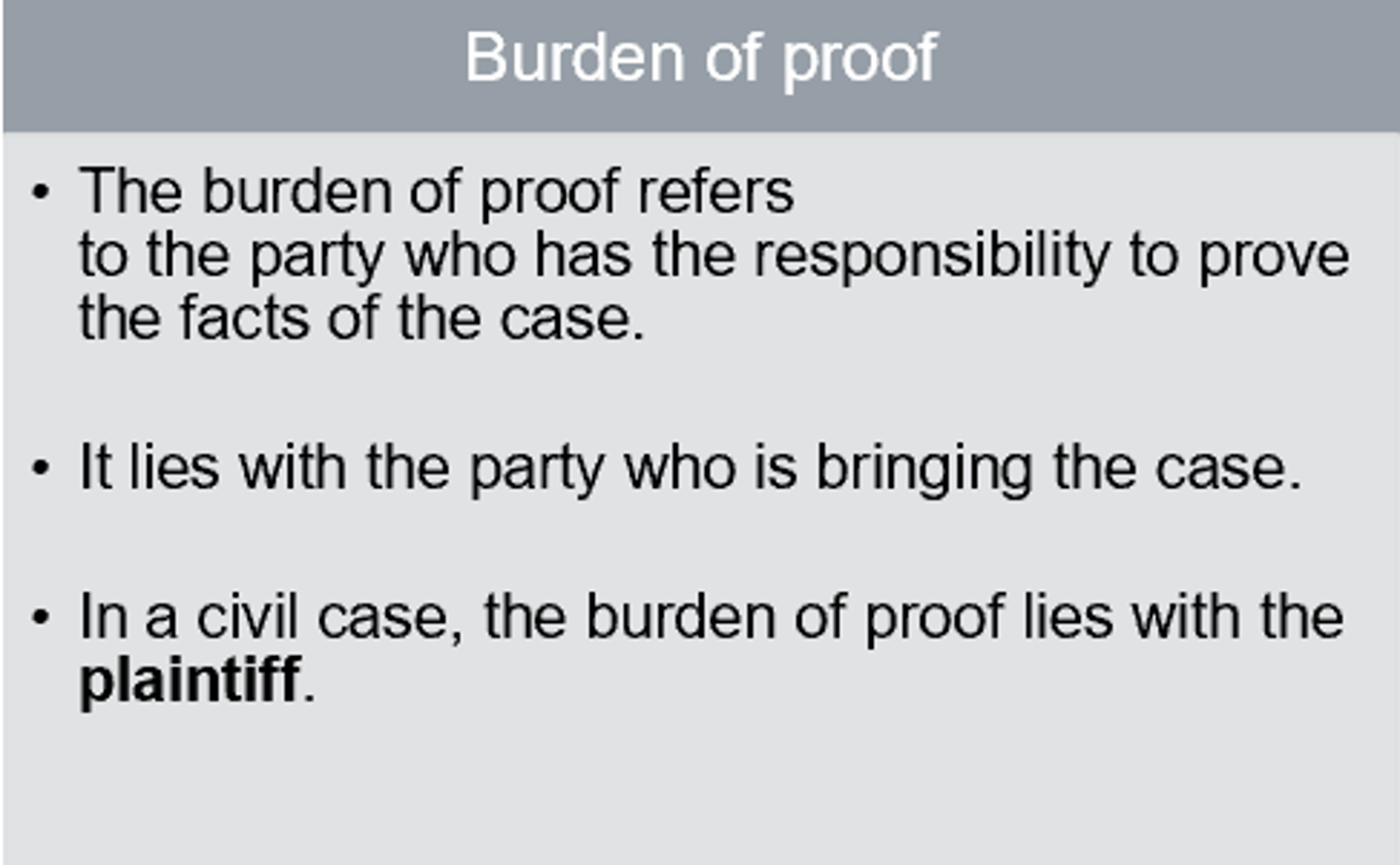
Standard of proof
Refers to the amount of evidence the plaintiff must present to the court to win/ There must be sufficient evidence to prove on the balance of probabilities that the facts claimed, by the plaintiff, are substantially true.

Fairness
All people can participate in the justice system and its processes should be impartial and open.
Examples of fairness within the civil justice system
- Courts and personnel, including judges, magistrates, jury members and mediators / arbitrators must be independent, impartial, and unbiased.
- Hearings are required to be public and court judgements are available to the public, allowing the community, media and victims to attend court hearings.
- Parties should have the opportunity to know the case against them and present their version of the case.
- Resolution with minimal delays, as delays can compound suffering of those whose rights have, in fact, been infringed.
Equality
All people engaging with the justice system and its processes should be treated in the same way. If the same treatment creates disparity or disadvantage, adequate measures should be implemented to allow everyone to engage with the justice system without disparity or disadvantage.
Examples of equality within the civil justice system
- Plaintiffs and the defendants are treated in the same manner (regardless of their age, gender, religion, disability, etcs) by all those within the court, VCAT, mediation services, etc.
- Similar cases should have similar outcomes, for instance when awarding damages for injury.
- Procedures applied equally and juries (when used) are given similar instructions about the law and decision they need to make.
Access
All people should be able to engage with the justice system and its processes on an informed basis.
Access in the civil justice system
- Those who suffer injury know that they have the legal right to seek a remedy
- When seeking redress for a civil wrong, knowing which legal body (VCAT, courts, CAV) or process to go to.
- AS a defendant in a claim for compensation, knowing what lawful defences may apply to reduce your liability.
Costs
In civil matters the party bears the costs of the action. The parties need to carefully consider the costs and the possible financial consequences if they are unsuccessful. They need to consider:
- What will it cost?
- Will I recover the costs?
- Will the defendant be able to pay the costs?
Costs on the parties
Legal fees are the fees set by the parties' legal representation. This can include separate fees for the law firm and for engaging a barrister to advocate at the trial.
Disbursements are the out-of-pocket expenses for bringing a case. These can include court filing fees, hearing fees, and jury costs.
When a party goes to trial and loses, they are ordered to pay the legal costs of the successful party. The award of costs will usually only cover part of the plaintiff's total legal expenses.
Limitation of actions
This is the time restriction on bringing a civil claim. Certain types of claims have different limitations. This is relevant to civil disputes as plaintiffs who bring claims after the relevant time period has expired may be barred from obtaining any remedy.
In Victoria, the main statute that imposes time limits is the Limitation of Actions Act 1958 (VIC)
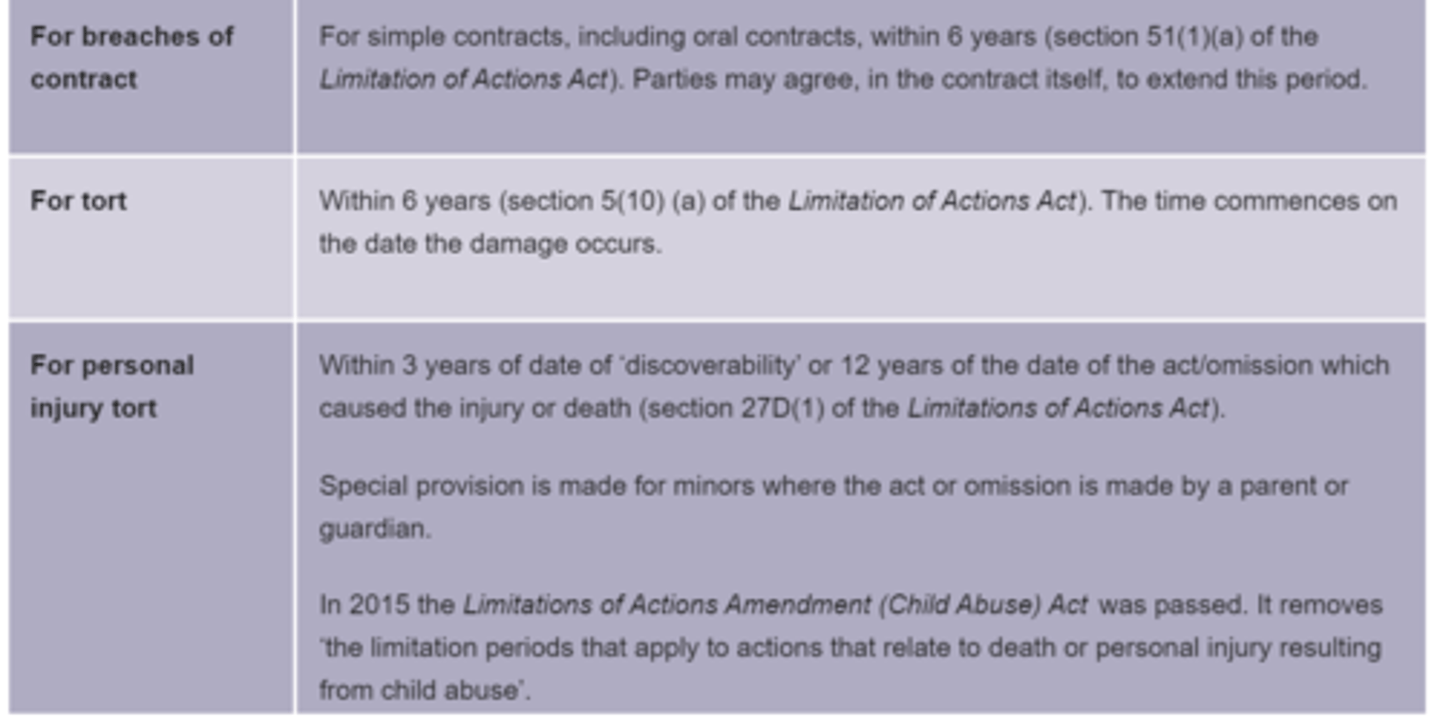
Exceptions to limitations of actions
- For persons who suffered physical or sexual abuse as a minor or psychological abuse that arose out of that abuse, there are no time limitations.
- The time limit can be extended in some circumstances (abuse and psychological trauma).
Purposes of limitations of actions
- Ensures that cases are initiated while recollections of events are fresh
- provide for personal and business certainty
- ensure that plaintiffs act within a timely manner to resolve issues.
Scope of liability
The plaintiff must establish a casual link between the defendant's actions and the harm caused. In negligence it must also be shown that it is appropriate for the scope of the defendant's liability to extend to the harm caused.
Scope of liability for negligence is stated in Section 51 of the Wrongs Act 1958 (VIC)
Enforcement issues
the fact that the plaintiff has been successful in a court action and has received a judgement against the defendant does not always ensure that they get paid the amount that has been awarded. If the court makes an award of damages that the defendant does not comply with, the court can enforce it by ordering:
- A warrant for distress
- A garnishee order
- An attachment of earnings
- Sequestration
- Bankruptcy and liquidation
- Imprisonment
The plaintiff needs to consider whether the defendant is able to pay:
- The defendant may be bankrupt, or for other reasons, be unable to pay
- the defendant may be in jail
- the defendant is a company
- the defendant may be overseas or uncontactable
- the plaintiff may not know who the defendant is
Alternative dispute resolution methods
Mediation
Conciliation
Arbitration
Mediation
A method of dispute resolution that uses an independent third party (i.e. a mediator) to help the disputing parties reach a resolution,
It is a tightly structured, joint problem-solving process in which the parties in a conflict sit down and (with the help of an independent mediator) discuss the issues involved, develop options, consider alternatives and try to reach an agreement through negotiation and compromise.
Any decision reached is voluntarily made by the parties. They may sign a terms of settlement that can be enforceable through the court.

How mediation is used
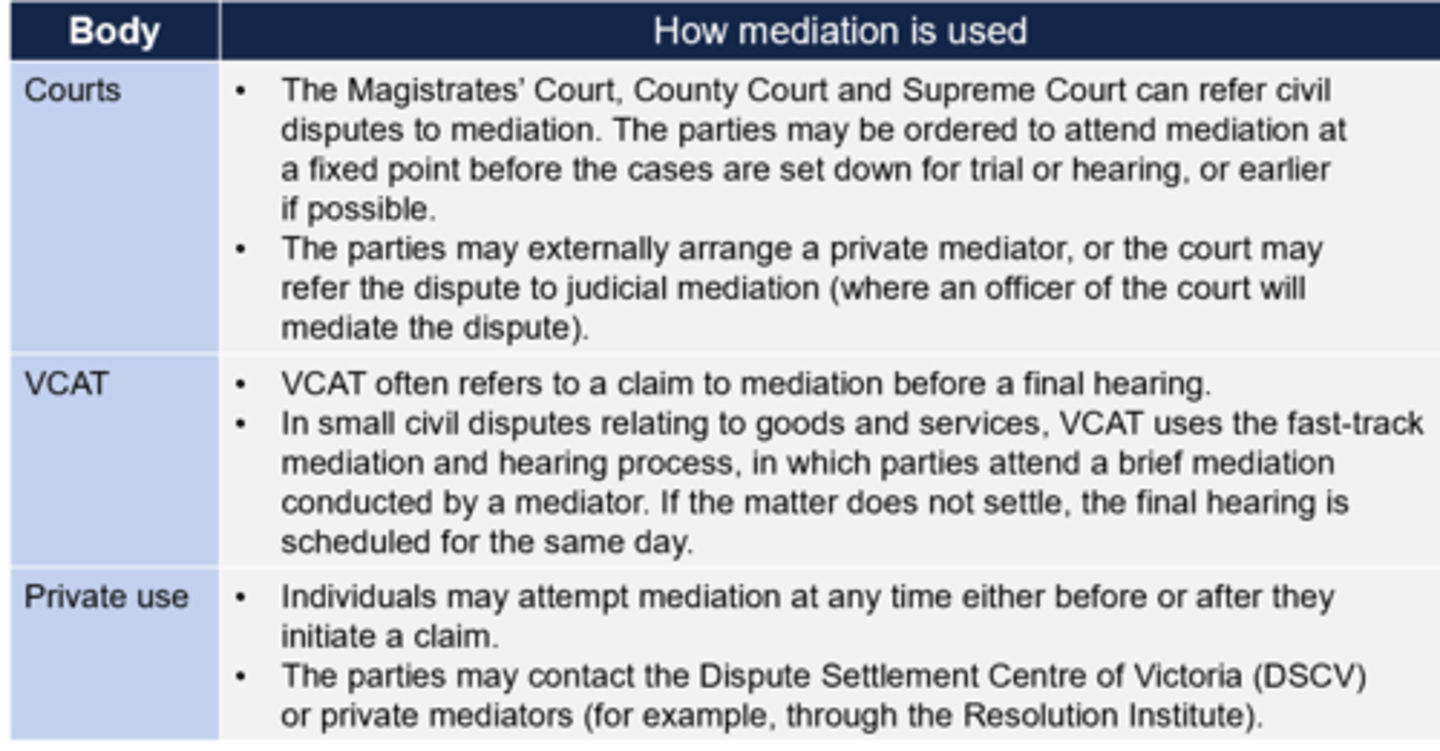
Conciliation
A method of dispute resolution that uses an independent third party (i.e. a conciliator) to help the disputing parties reach a resolution.
A conciliator has some influence over the outcome as they are usually someone with specialist knowledge and can suggest options and possible solutions to resolve the dispute.
Any decision reached is voluntarily made by the parties. They may sign a terms of settlement that can be enforceable through a court.

How conciliation is used
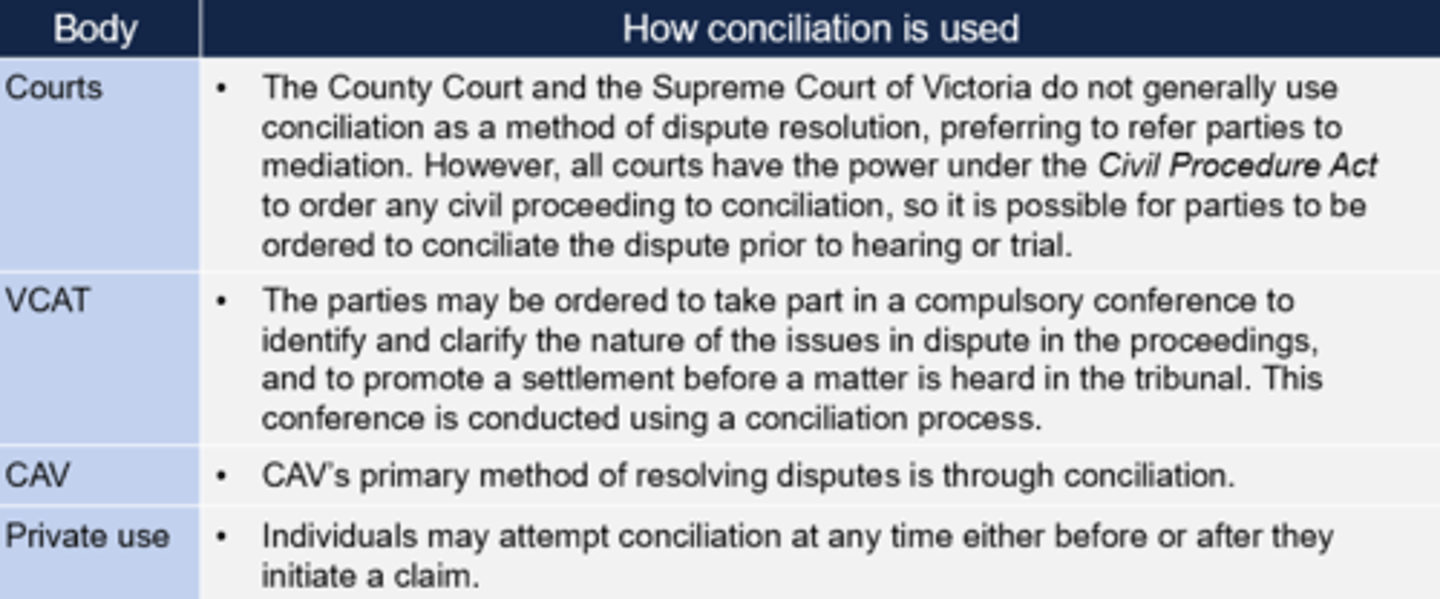
Points to consider when determining whether mediation and conciliation are appropriate include:
- whether the relationship between the parties will continue
- whether the parties are willing to meet in a spirit of compromise
- whether there is a history of violence and threatening behaviour
- whether one of both of the parties want privacy and confidentiality
- when the mediation or conciliation is to be held
- whether the matter is urgent
- whether there is a gross imbalance of power
Strengths of mediation and conciliation
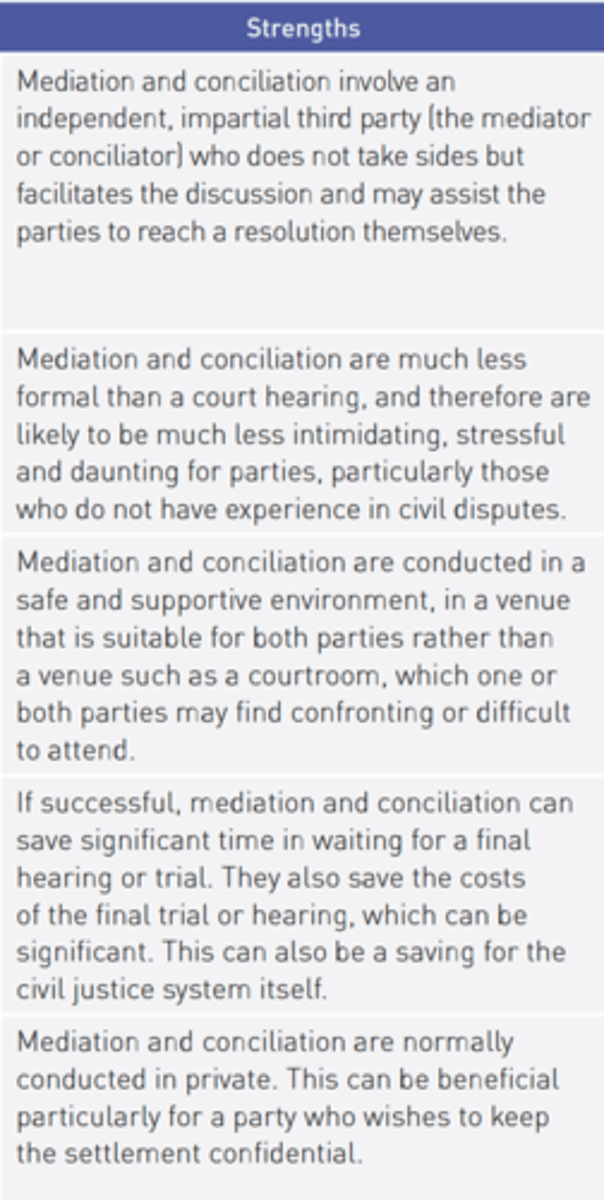
Weaknesses of mediation and conciliation
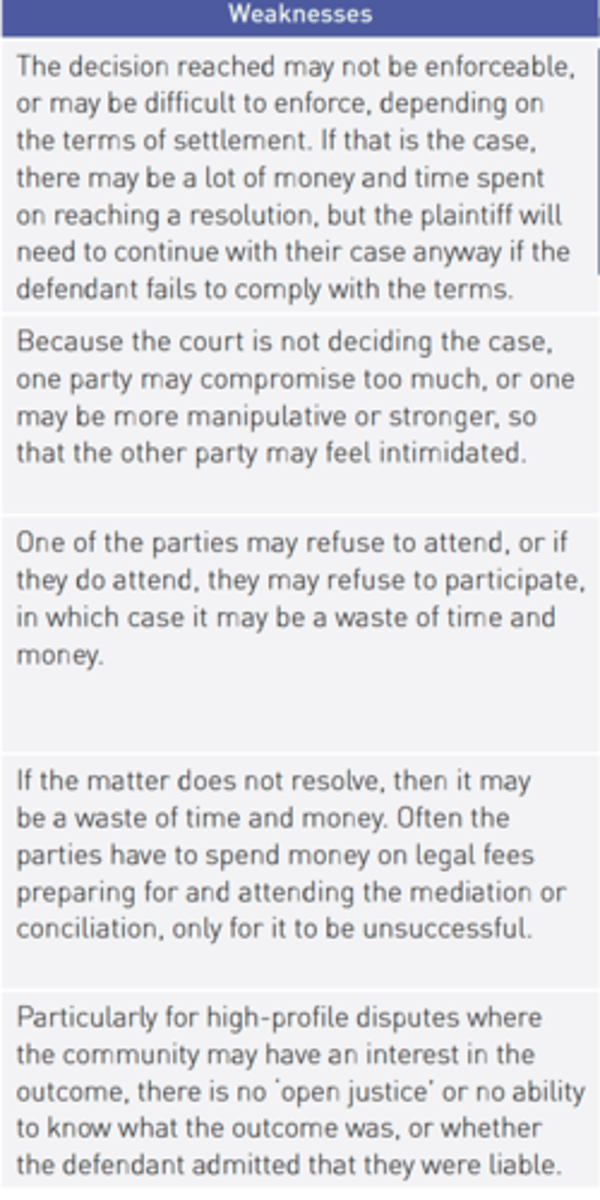
Arbitration
A method of dispute resolution in which an independent person (an arbitrator) is appointed to listen to both sides of a dispute and make a decision that is legally binding on the parties. The decision is known as an arbitral award.
Arbitration is often conducted in private, and it can be less formal and more cost-effective than attending a court hearing or trial.
The final order is known as an 'arbitral award' and is enforceable.

How arbitration is used
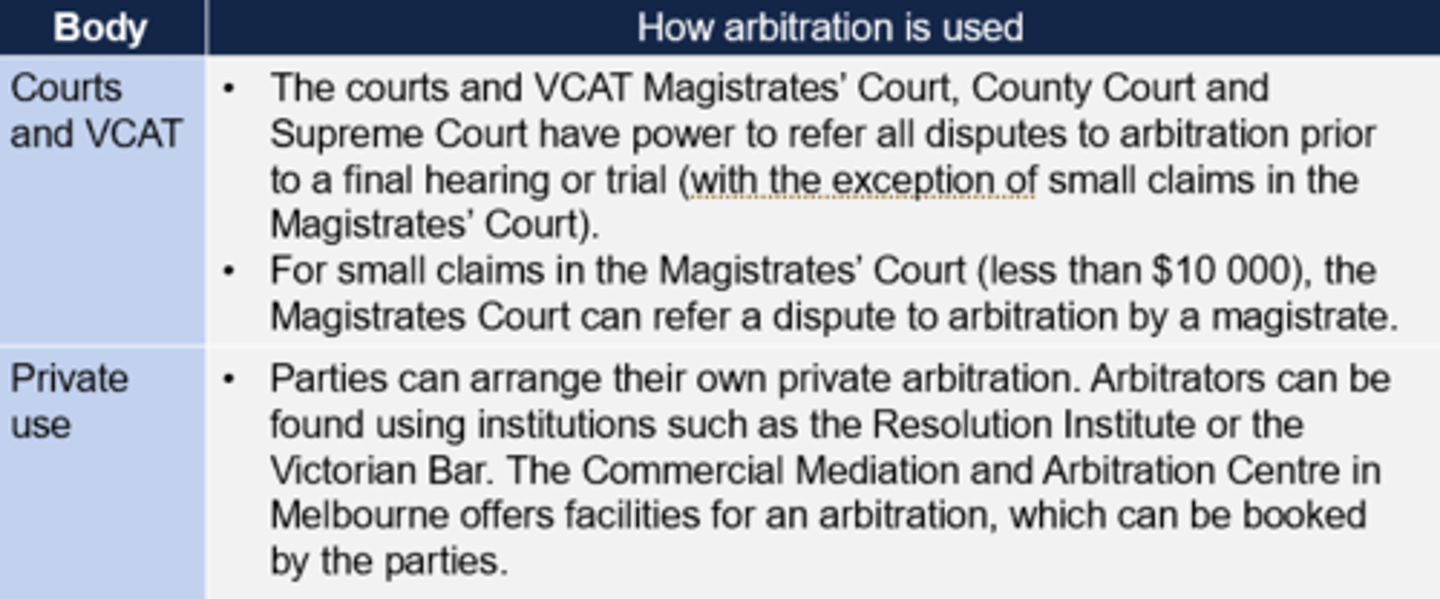
Points to consider when determining whether arbitration is appropriate include:
- whether the parties have agreed to arbitrate the dispute or the claim is less than $10,000 and has been issued in the Magistrates' Court.
- whether the parties want binding and enforceable decision made by an independent third party, or whether they would prefer to have control over the outcome and decide on that outcome themselves
- whether the parties wish to have the dispute considered by a third party and want evidence to be presented to that third party as part of the dispute
- whether one or both of the parties want the dispute to be resolved privately or confidentially, or whether they want a public record of what occurred.
Strengths of arbitration
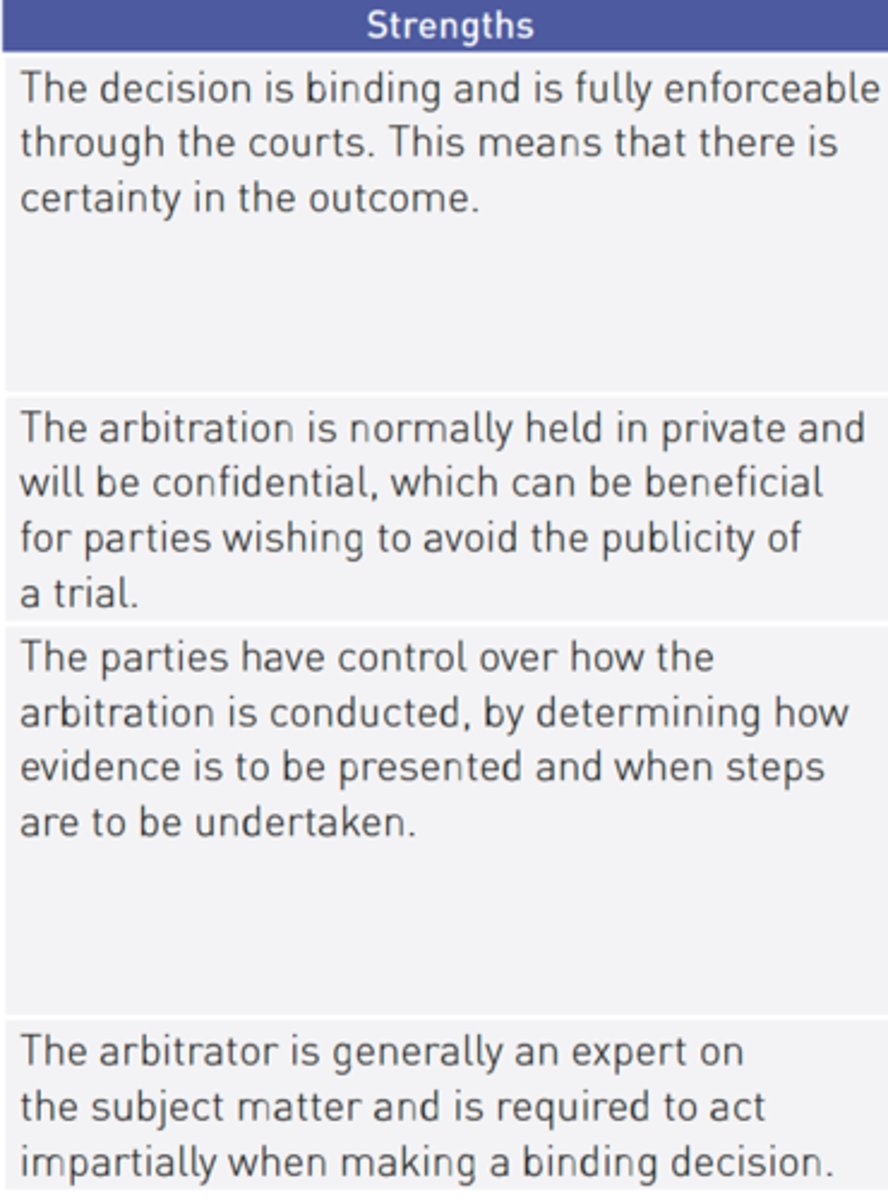
Weaknesses of arbitration
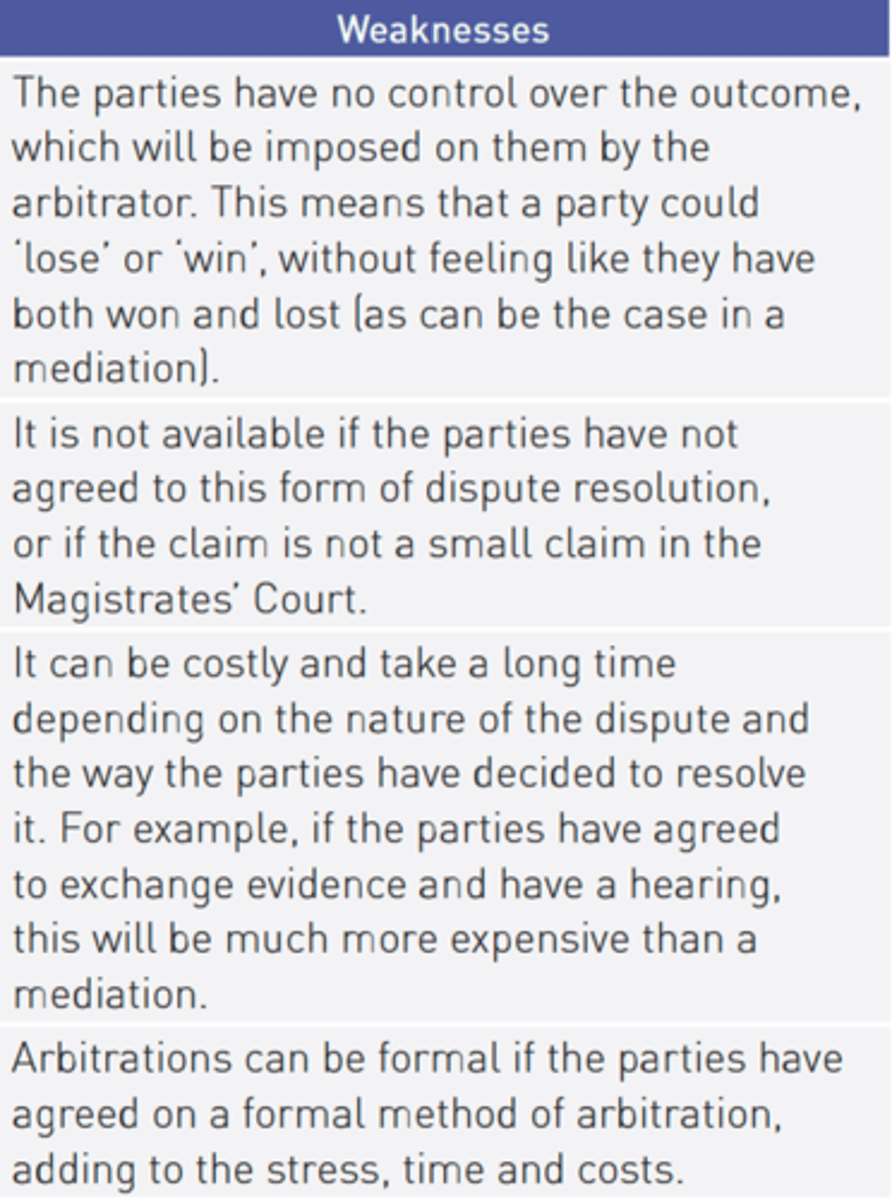
Comparison of dispute resolution methods
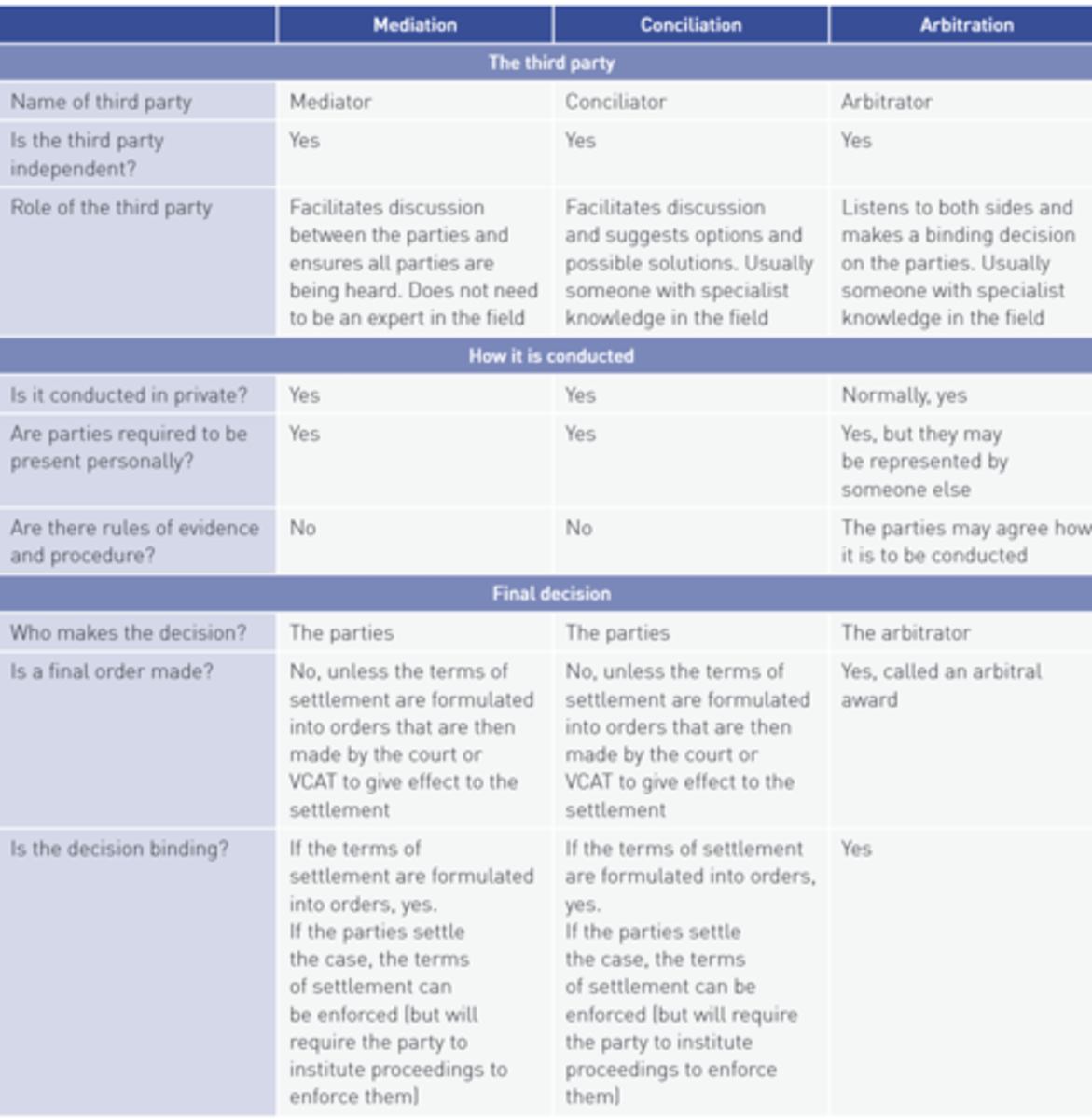
The Victorian Court Hierarchy
Victoria's court are arranged in a hierarchy, ranked in order of the complexity and severity of cases they hear. Each court in the hierarchy has its own jurisdiction (powers) to hear civil cases.
Reasons for the court hierarchy include administrative convenience and appeals.
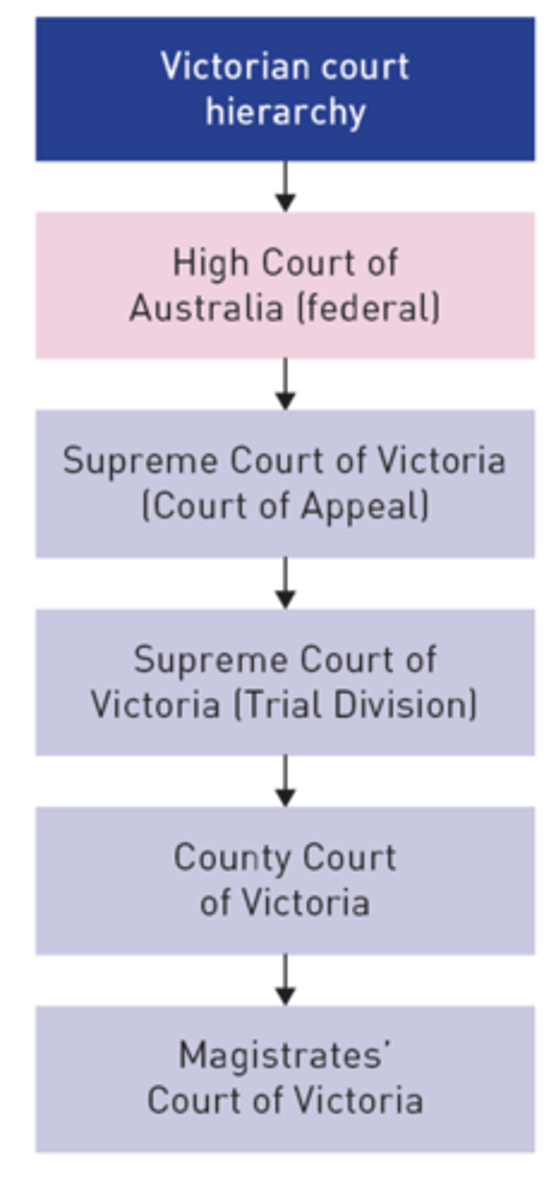
Administrative convenience

Appeals
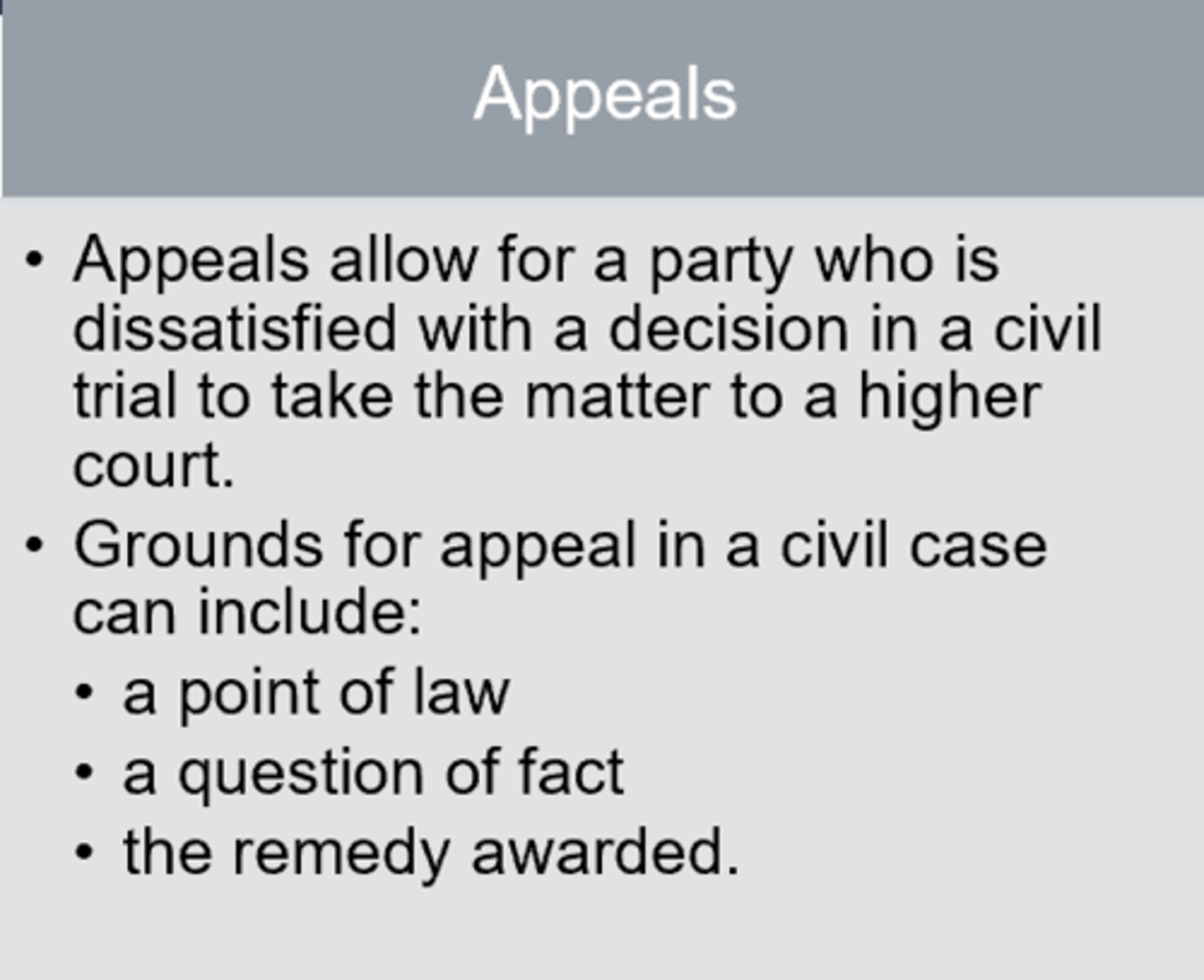
Civil jurisdiction of the Victorian Courts
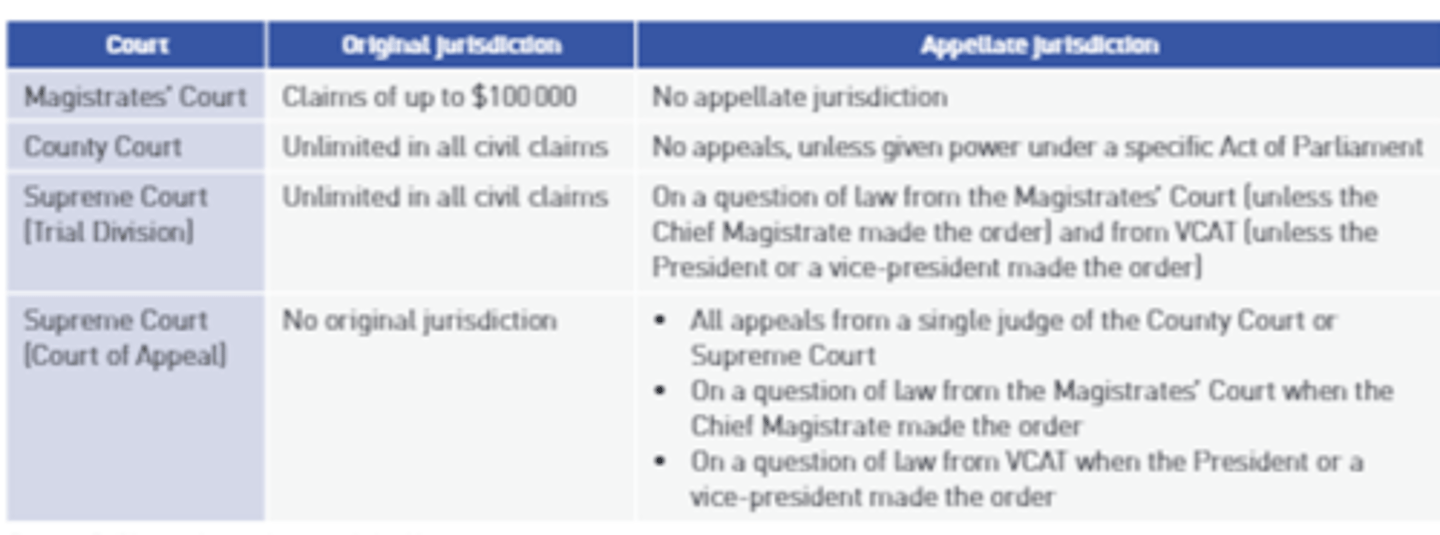
Strengths of the court hierarchy
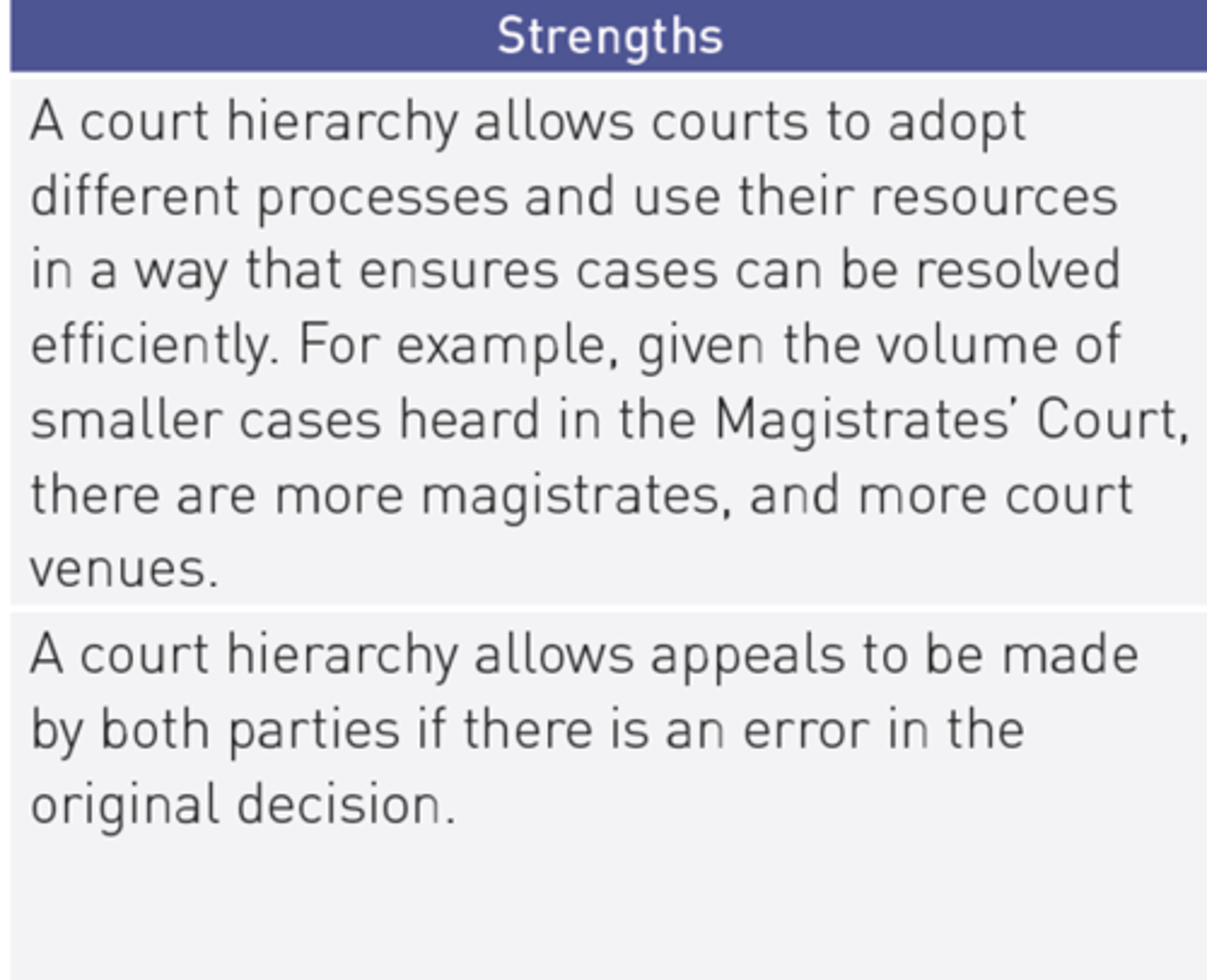
Weaknesses of the court hierarchy
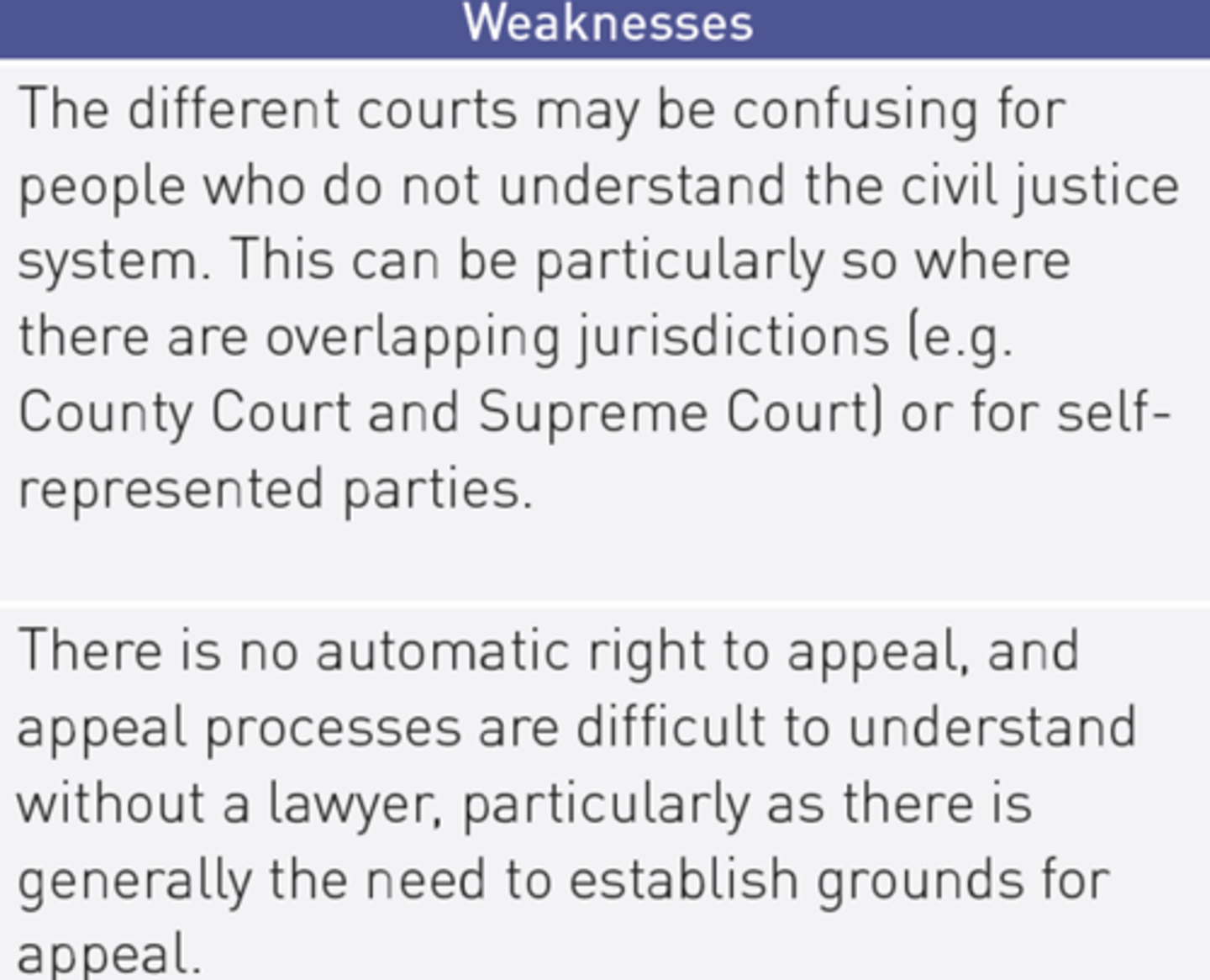
The judge and the Magistrate
- Act impartially
- Case management (before trial or hearing)
- Case management (during trial or hearing)
- Determine liability and the remedy
- Decide on costs
Case management powers
Include the power to give directions to parties. For example, directions to parties to complete pre-trial procedures by a certain date, or to attend mediation.
Judges and magistrates are given cases management powers to ensure the just, efficient, timely, and cost-effective resolution of the real issues in dispute.
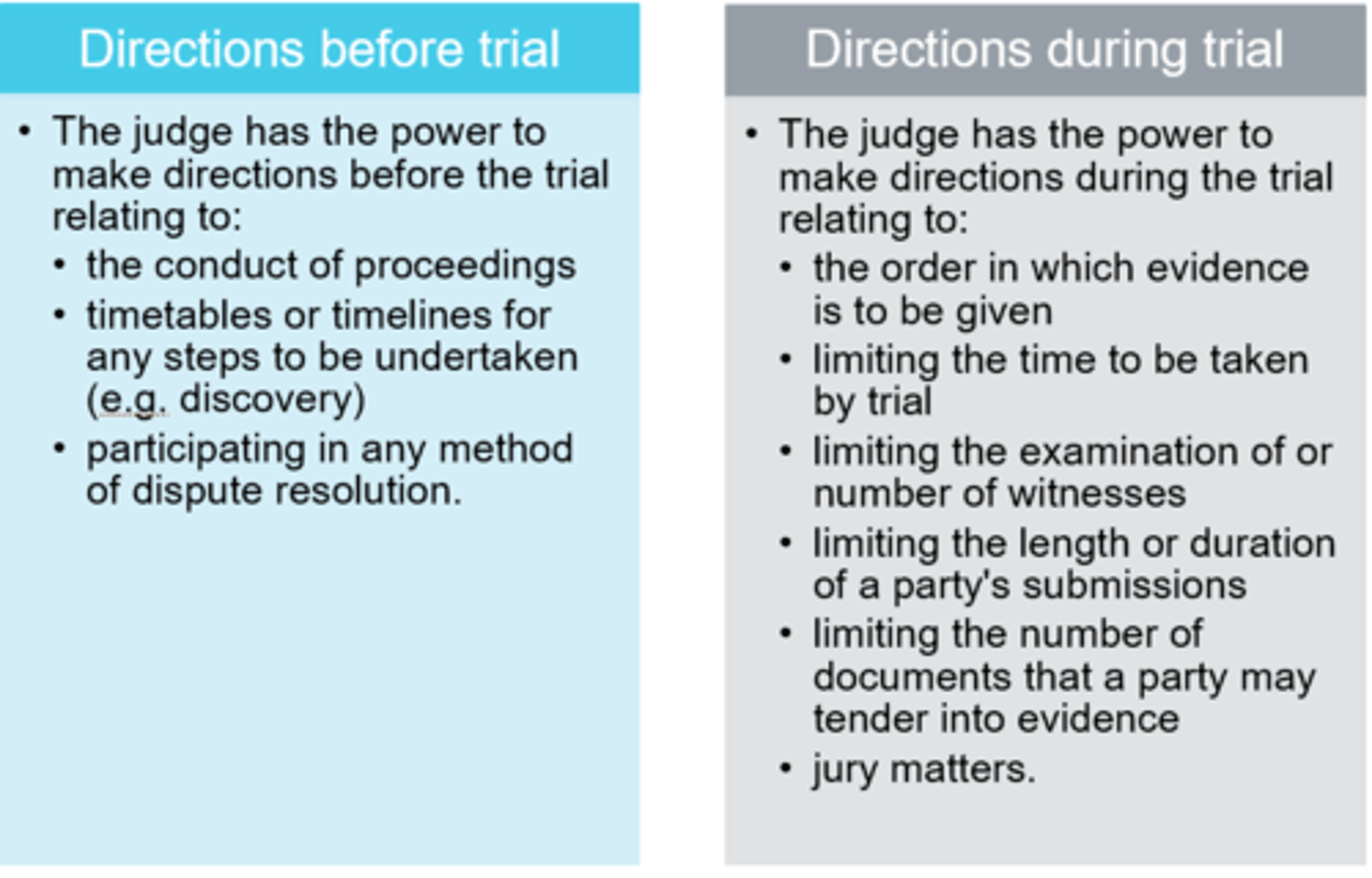
Similarities of the judge or magistrate in a criminal and civil case

Differences of the judge or magistrate in a criminal and civil case
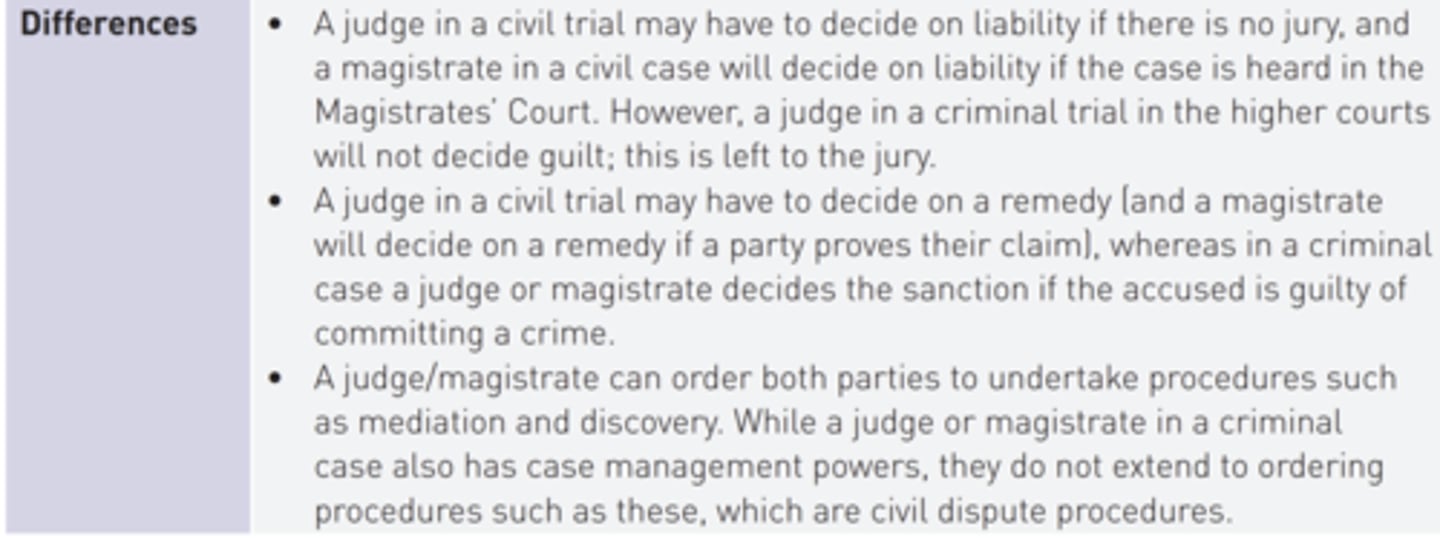
Strengths of the judges / magistrates
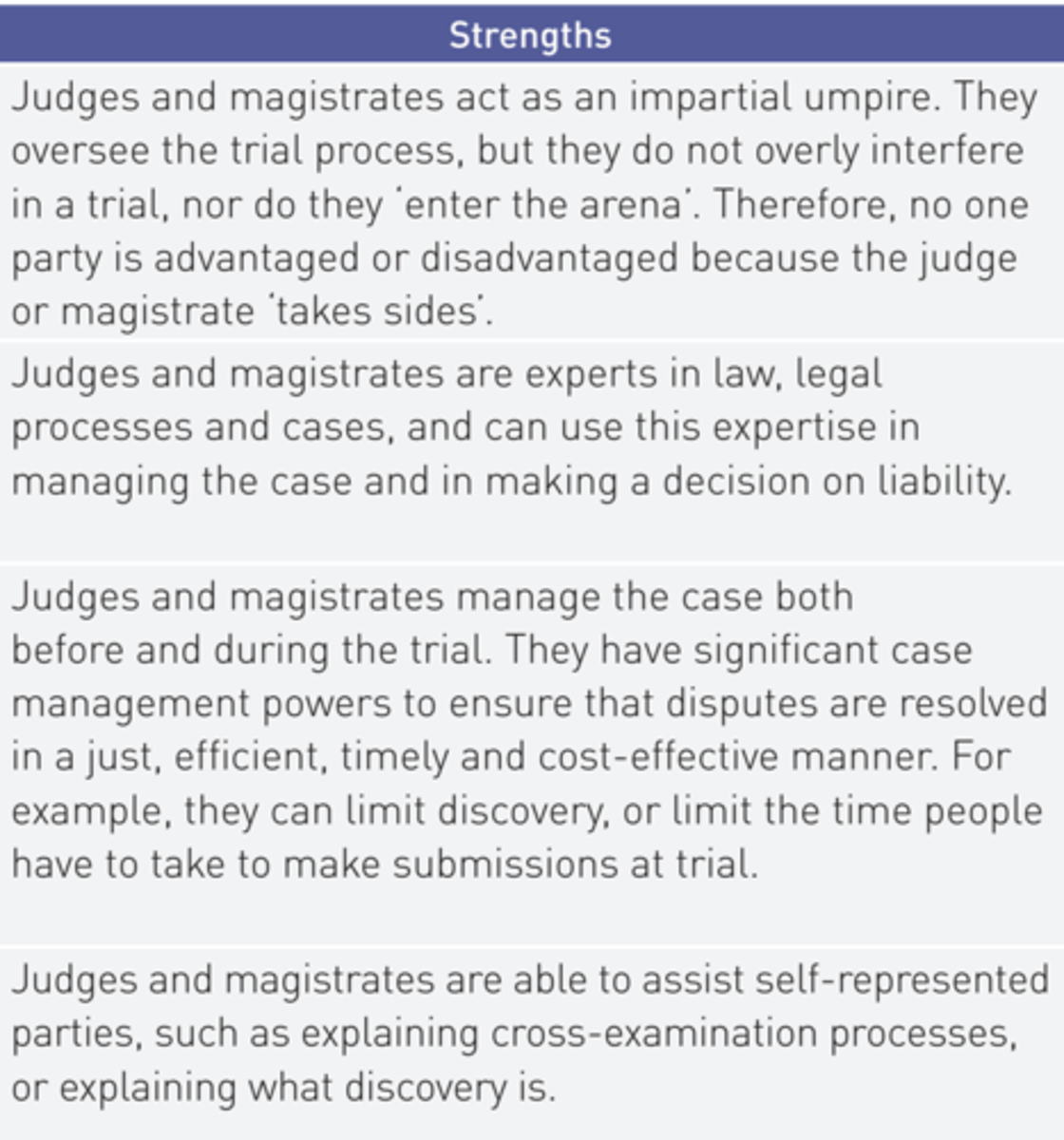
Weaknesses of the judges / magistrates
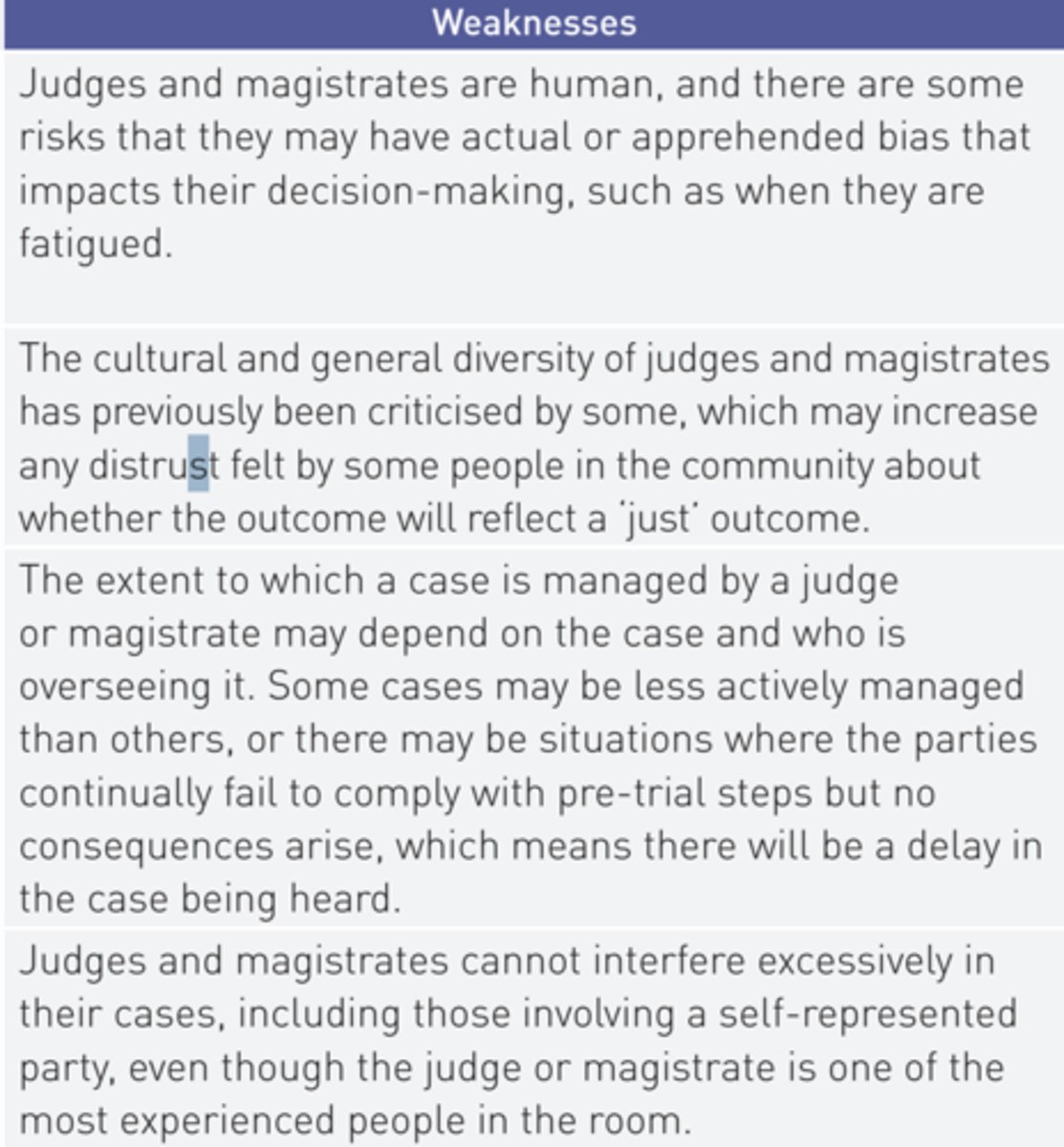
Role of the jury
Civil juries comprise six juror chosen randomly from the electoral roll.
Juries may be used in two situations:
- The plaintiff or defendant can request a jury. The one who orders the jury will have to pay for them (this is specified in the pleading stage)
- the court may order that a proceeding be tried with a jury (rare)
Juries will normally also assess the damages (except in defamation cases).
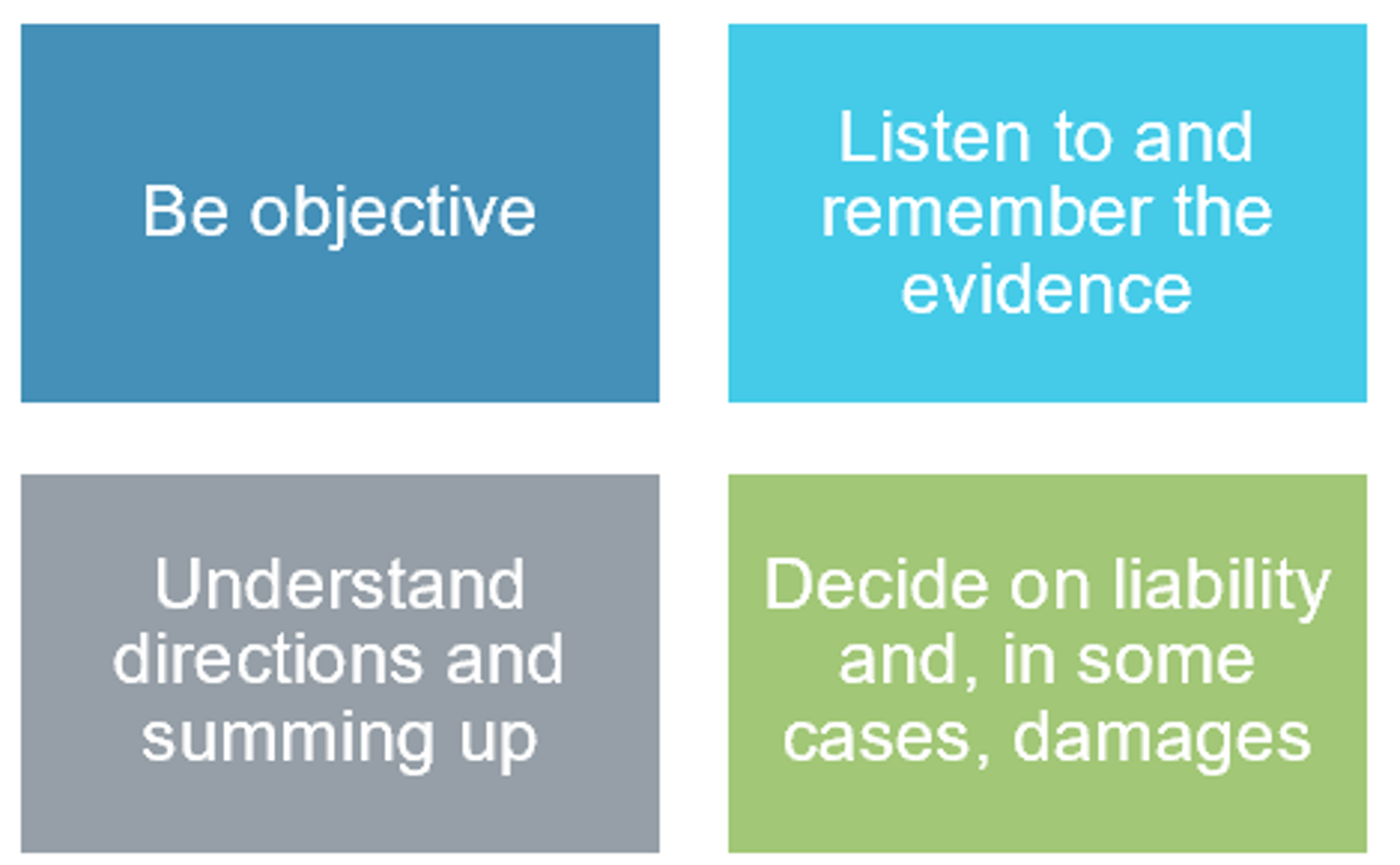
Pleading stage
A pretrial procedure during which documents are filed and exchanged between the plaintiff and the defendant which state the claims and defenses in the disputes.
Responsibilities of a civil jury
- The jury must be objective and make their decision without any prejudice or preconceived ideas. - The jury must listen to and remember the evidence so that they can make the most informed decision based on the evidence in the hearing.
- The jury must understand directions and summing up given by the judge about issues or points of law so that they can make a decision based on those directions.
- The jury must decide on liability and, in some cases, damages. The jury must decide whether the plaintiff has proved their case on the balance of probabilities, and try to reach an unanimous verdict.
Similarities of juries in criminal law and juries in civil law

Differences of juries in criminal law and juries in civil law

Strengths of jury in civil trial
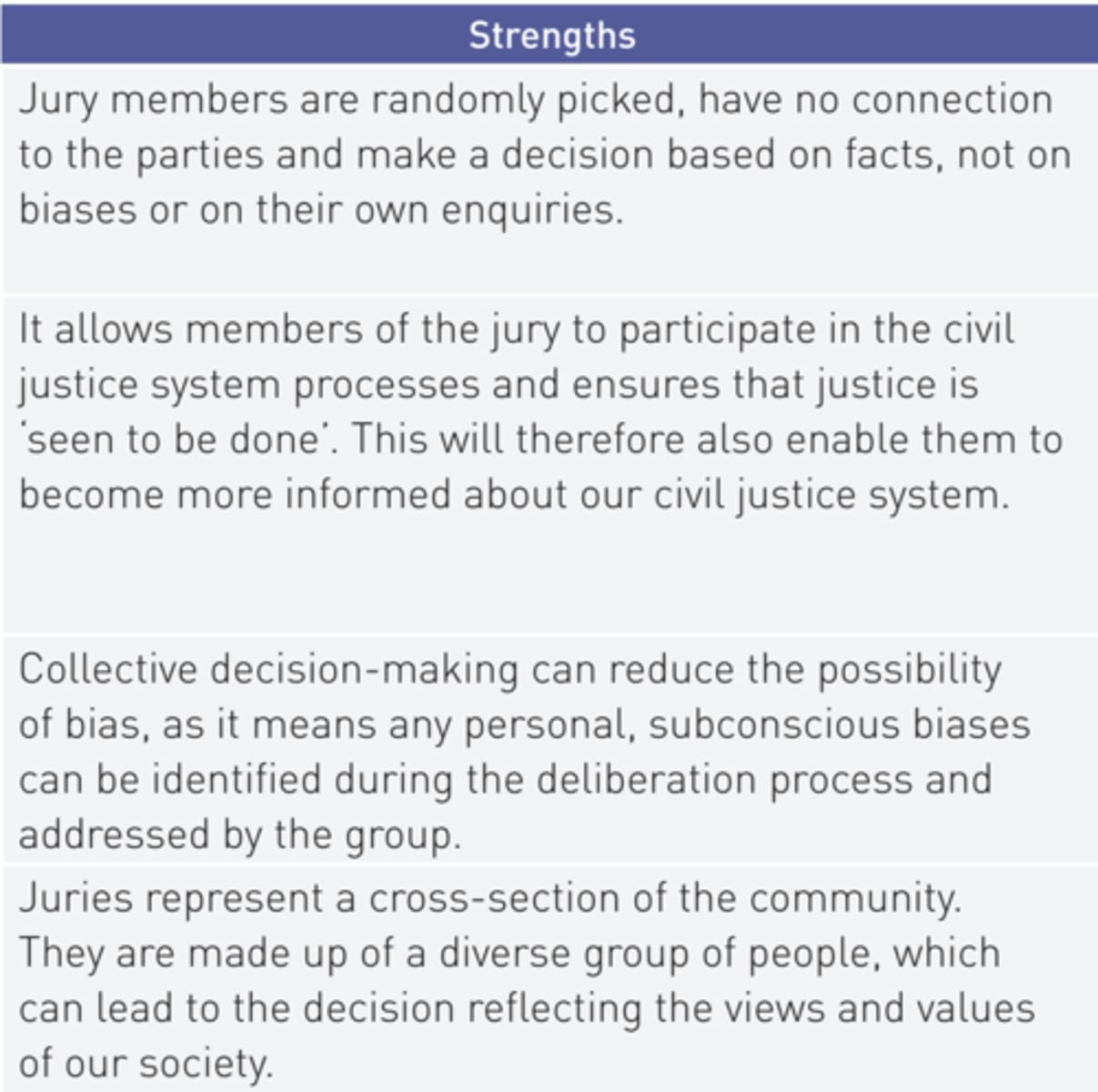
Weaknesses of jury
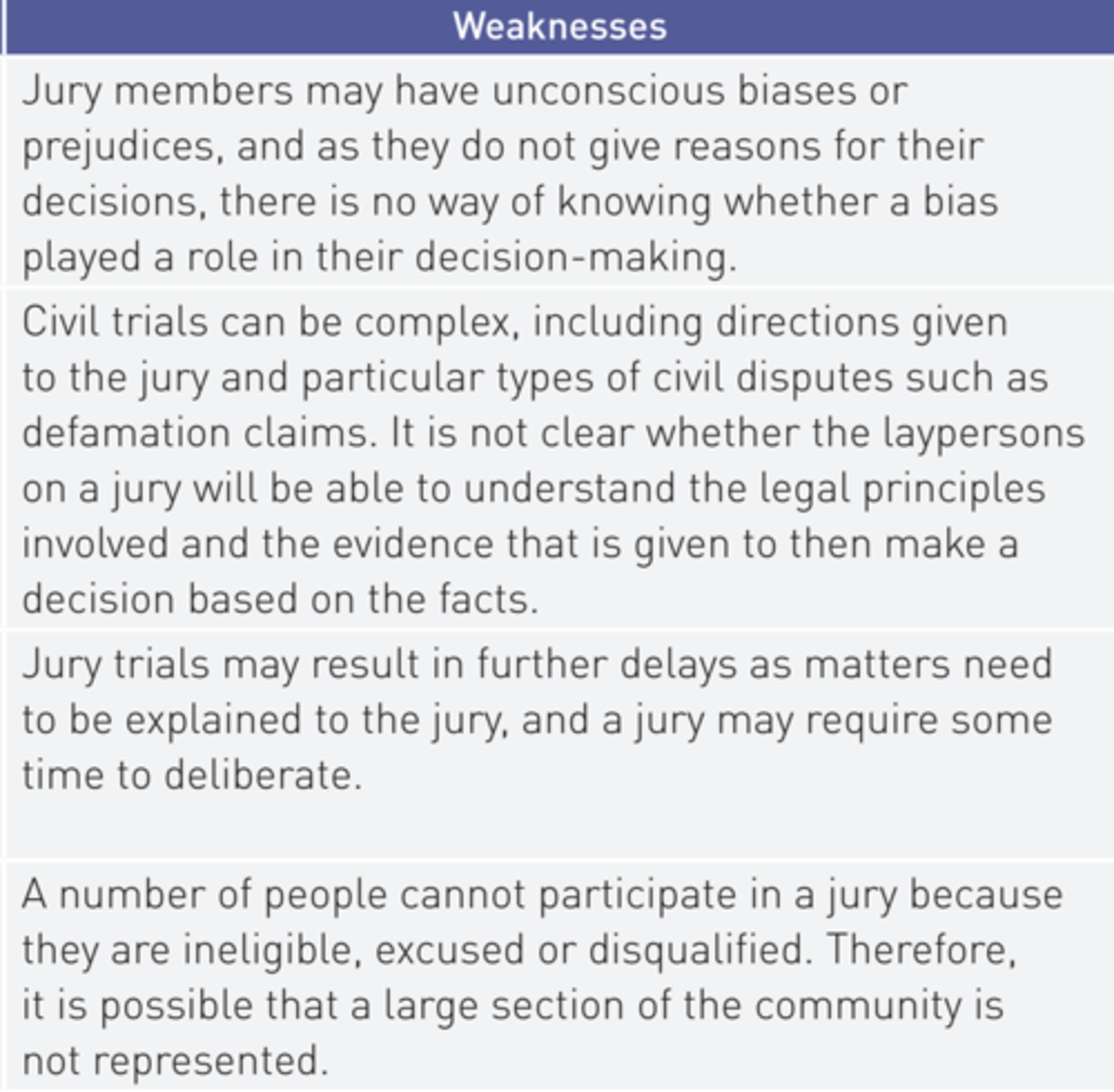
Roles of the parties
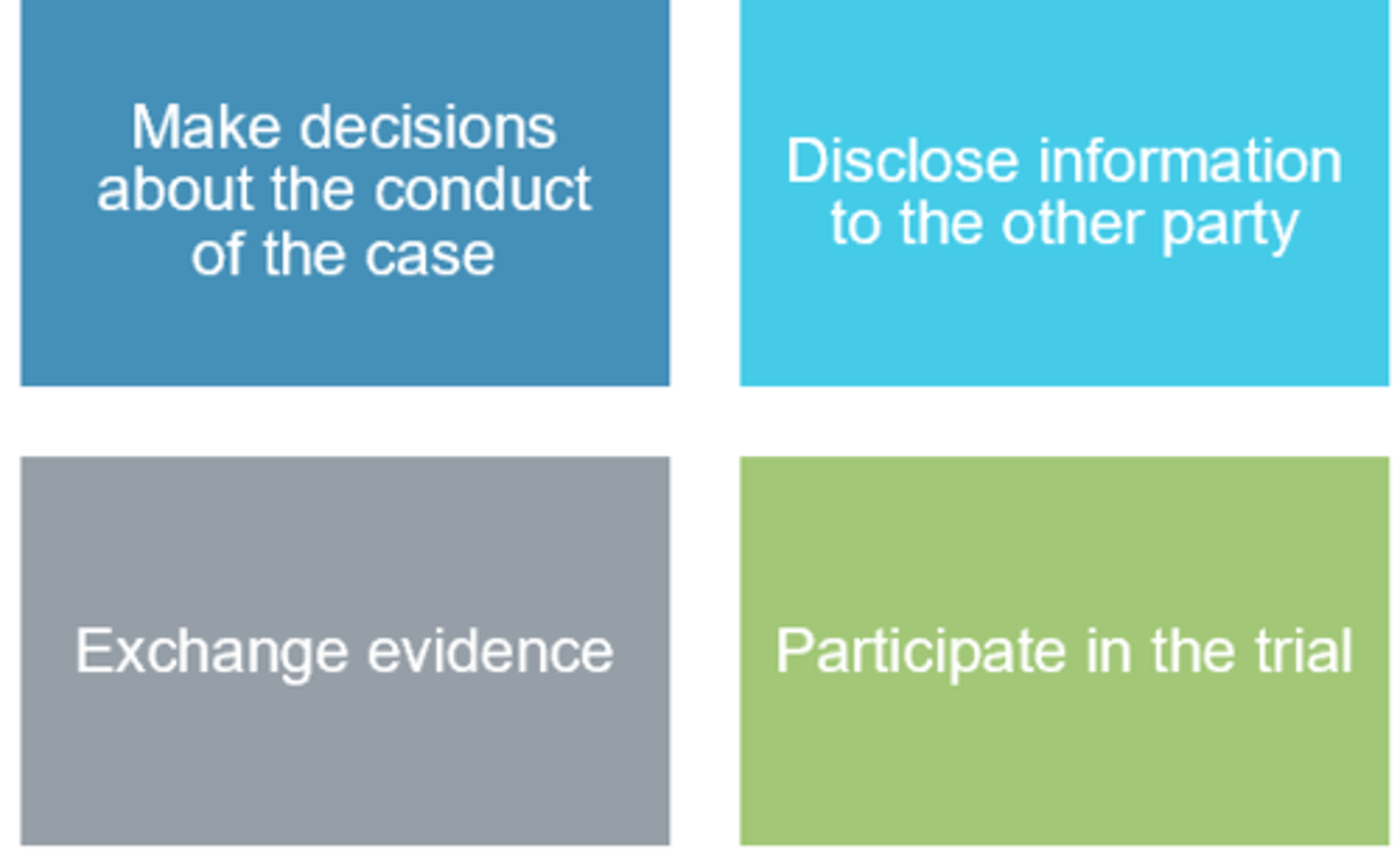
Strengths of the parties
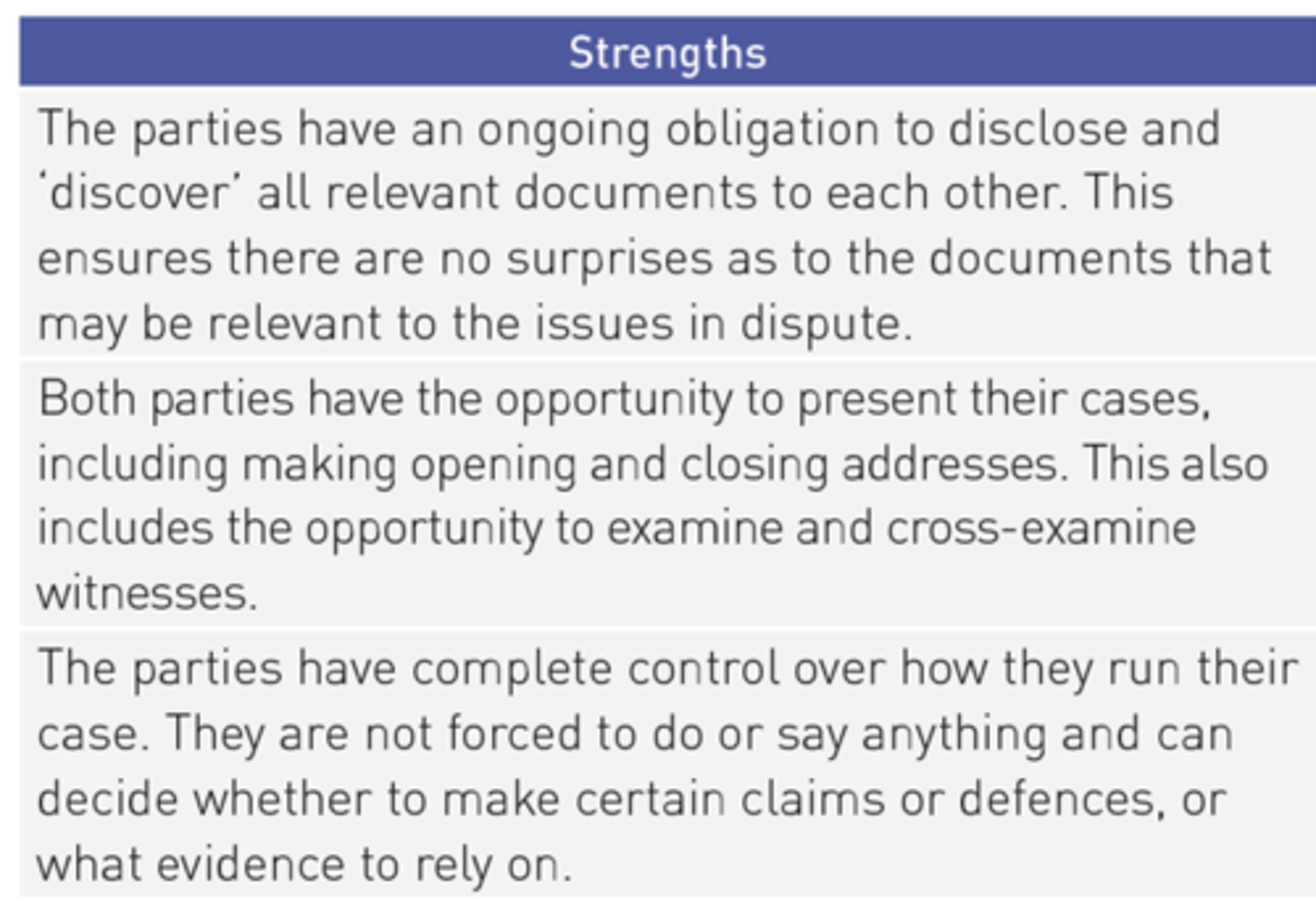
Weaknesses of the parties
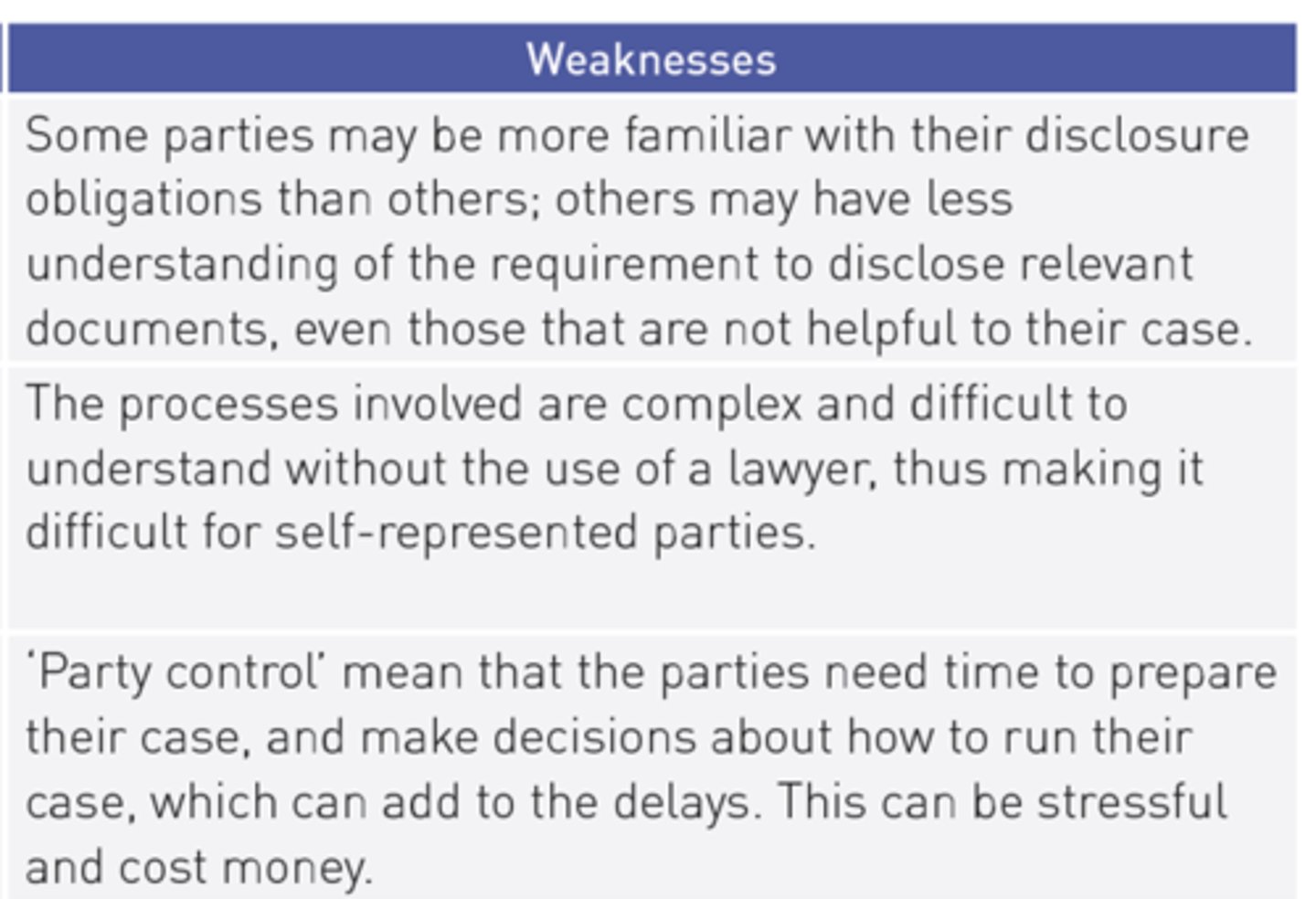
Counter claim
a separate claim made by the defendant in response to the plaintiff's claim (and usually heard at the same time by the court)
Party control
(in relation to criminal and civil cases) a term used to describe the power that each party in a legal case has to decide how they will run their case
Lay evidence
Evidence (testimony) given by a layperson (an ordinary person) about the facts in dispute
Expert evidence
Evidence (testimony) given by an independent expert about an area within their expertise
Examination-in-chief
The questioning of one's own witness in court in order to prove one's own case and disprove the opponent's case
The need for legal practitioners
- Parties may not know how to present their evidence in the most effective way or how to cross-examine a witness
- A self-represented party may be too emotionally invested in the case to be able to make objective decisions about the way they argue their case
Solicitors
A lawyer who advises clients about legal matters, prepares legal documentation for trial, communicates with the other party's legal representation, researches the relevant laws, and when required engages the services of a barrister and briefs them to represent a client in court.
Their main role is in all of the preparations in the lead up to the trial. Due to the complex nature of pursuing a legal matter a solicitor's expertise in legal documentation and relevant laws can help in preparing a party for trial.
Barrister
A self-employed lawyer who regularly appears in court and is responsible for representing a party in a trial by making legal arguments, questioning witnesses, and summarising the case to the judge and/or jury.
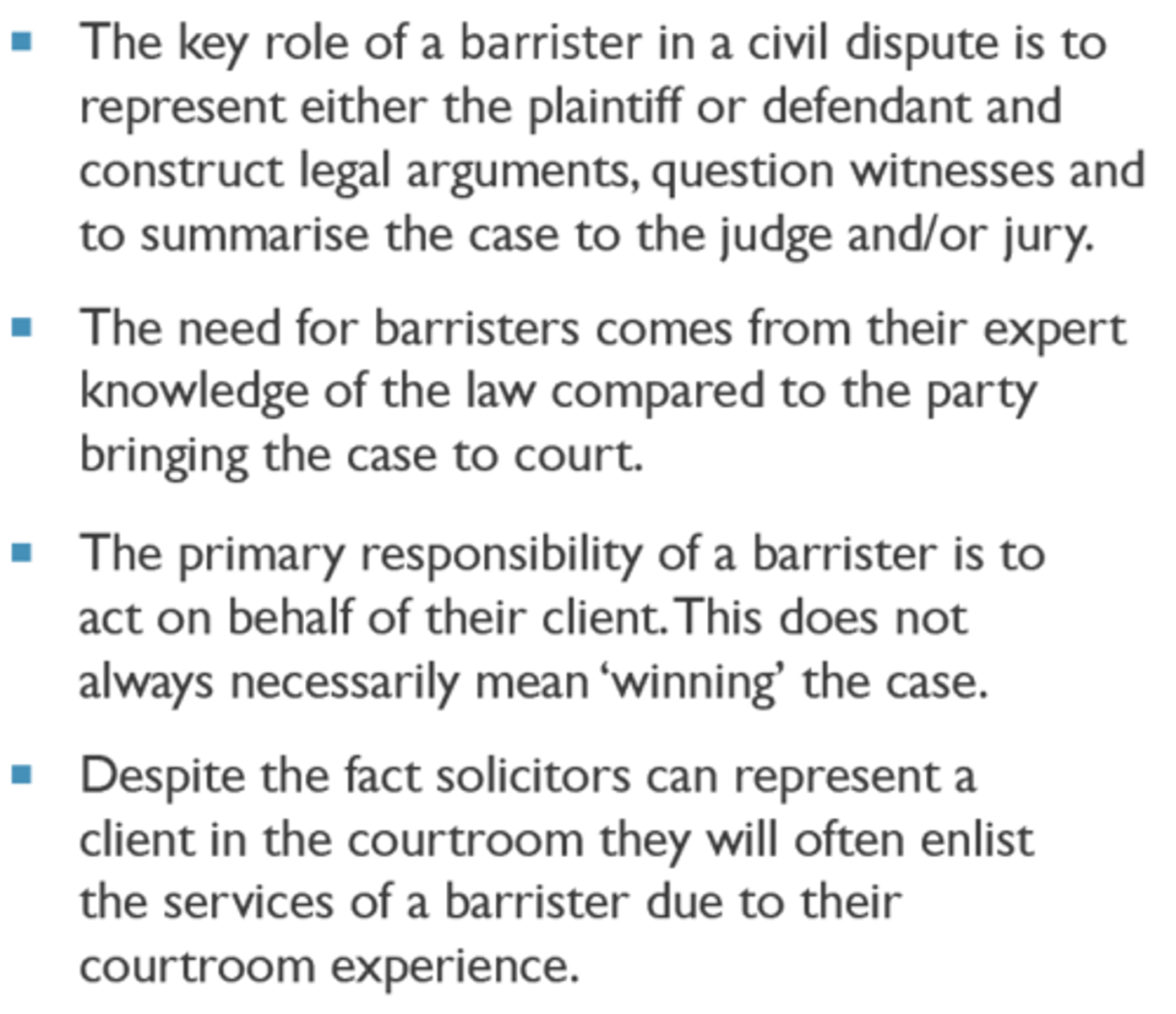
Strengths of legal practitioners
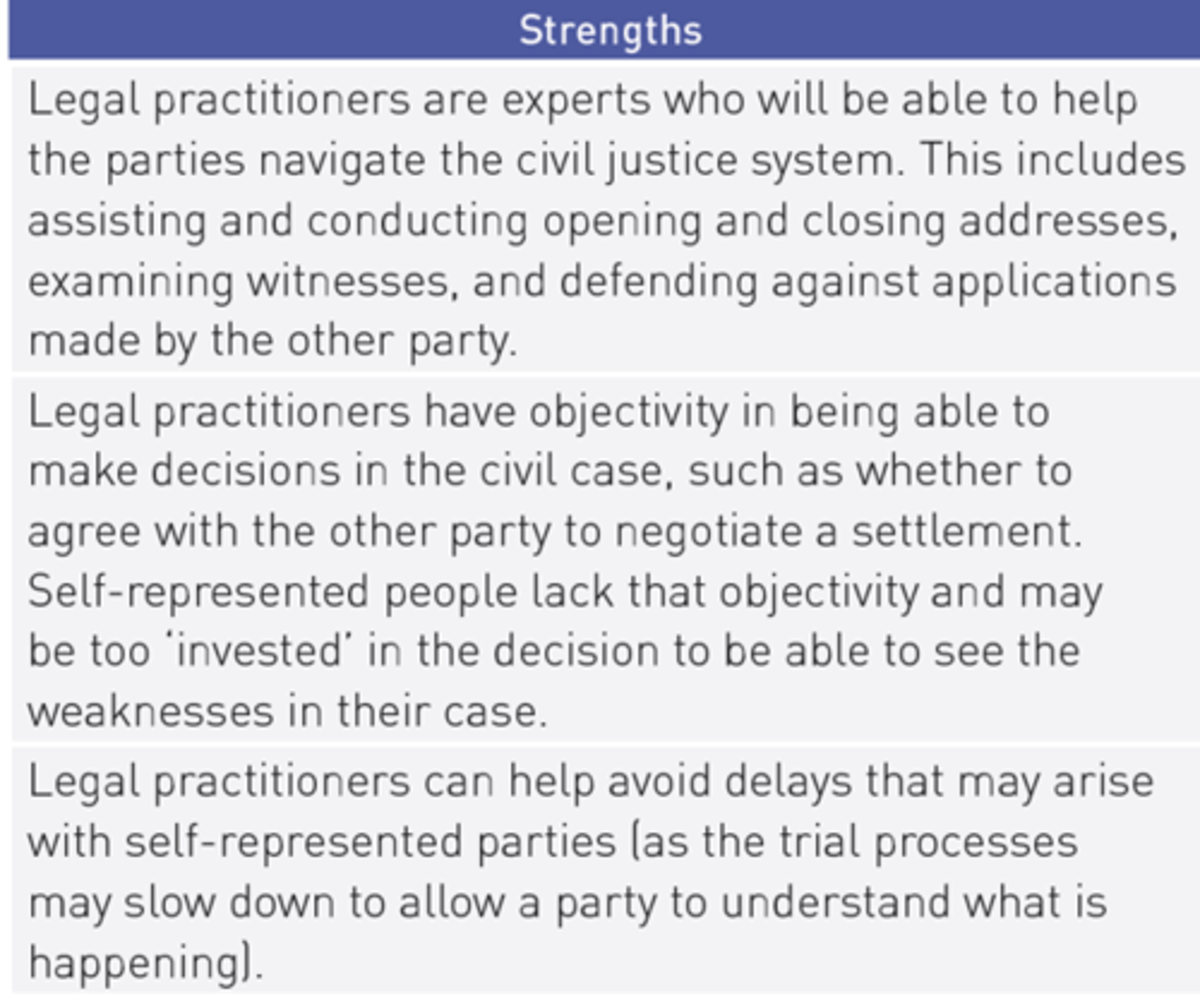
Weaknesses of legal practitioners
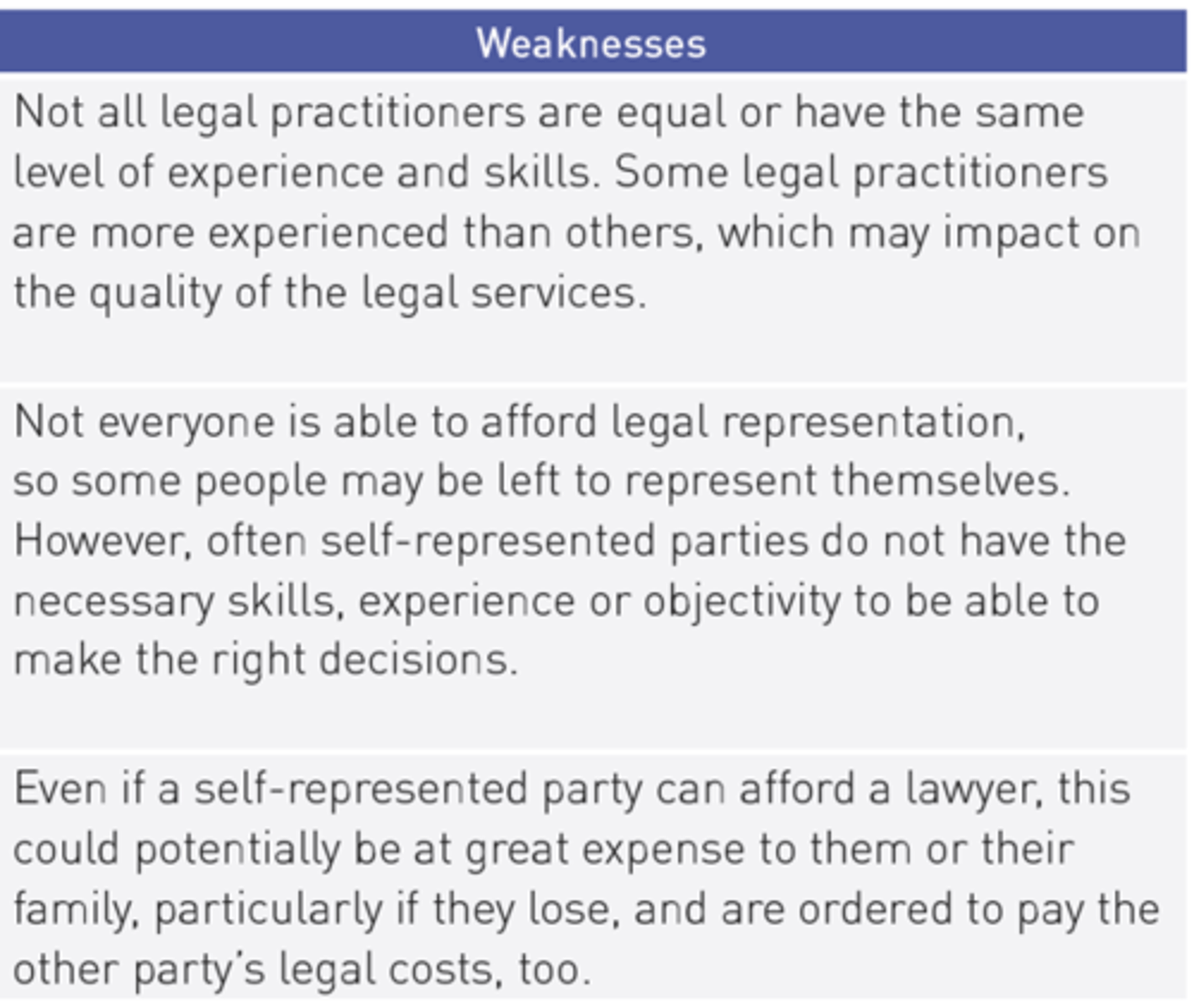
Class action
(Also referred to as a group proceeding or a representative proceeding) is a type of proceeding where a group, who all have claims against the same party, join together in a proceeding.
A class action can be commenced if
- seven or more people have claims against the same person
- those claims related to the same, similar or related circumstances
- the same issued needs to be decided
How class actions work
•Class actions are normally commenced by a lead plaintiff, the person who is named as the plaintiff in a class action and represents the group members.
•Group members do not actively participate in the proceeding.
•The court actively manages and supervises class actions to ensure fairness for group members, including approving any settlement agreed to between the parties and the legal fees for litigation funders.
•Most class actions settle prior to trial.
Costs in class actions
Generally, if a class action fails, the lead plaintiff is responsible for the costs of the proceeding and any potential adverse costs order.
Class actions can be funded by law firms or litigation funders, who usually take a percentage of any settlement or damages awarded
Types of class actions
- shareholder class actions
- product liability actions
- employee class actions
- natural disaster class actions
Appropriateness of class actions
- Whether there are seven or more people who have a claim against the defendant which arises out of the same or similar circumstance
- whether a plaintiff law firm or a litigation funder is prepared to fund is prepared to fund the claim to avoid the lead plaintiff from having the burden of costs
- whether there is someone willing and able to be the lead plaintiff
- the nature and size of the claims
- whether one group member has suffered significantly more than other group members and may be prepared to conduct their own proceeding, and fund it, rather than having to 'share' any settlement with the group members
Strengths of class actions
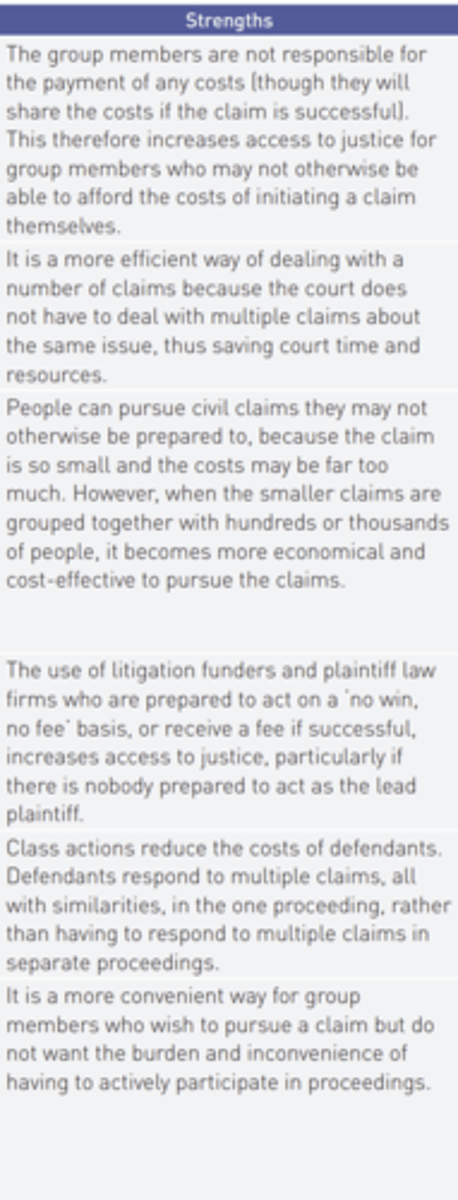
Weaknesses of class actions
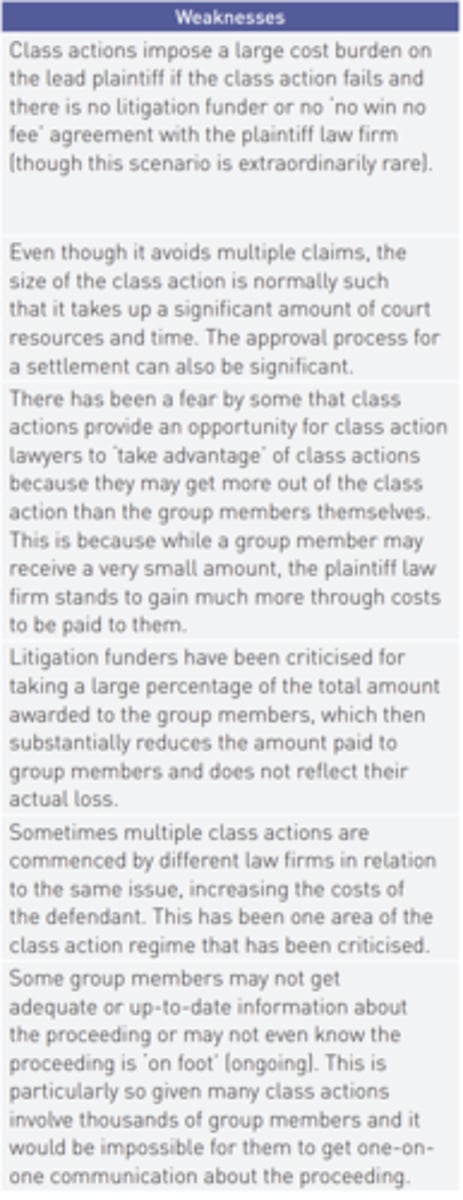
Lead plaintiff
The person who is named as the plaintiff in a class action and represents the group members; also sometimes referred to as the representative plaintiff
Group member
A member of a group of people who is part of a class action
Litigation funder
A third party who pays for some or all the costs and expenses associated with initiating a claim in return for the amount recovered. Litigation funders are often involved in class actions
Adverse costs order
an order (i.e. legal requirement) that a party pay the other party's costs
CAV
Consumer Affairs Victoria.
They are not a court or tribunal, and is a government complaints body and therefore doesn't have the power to force parties to attend conciliation or agree to a resolution.
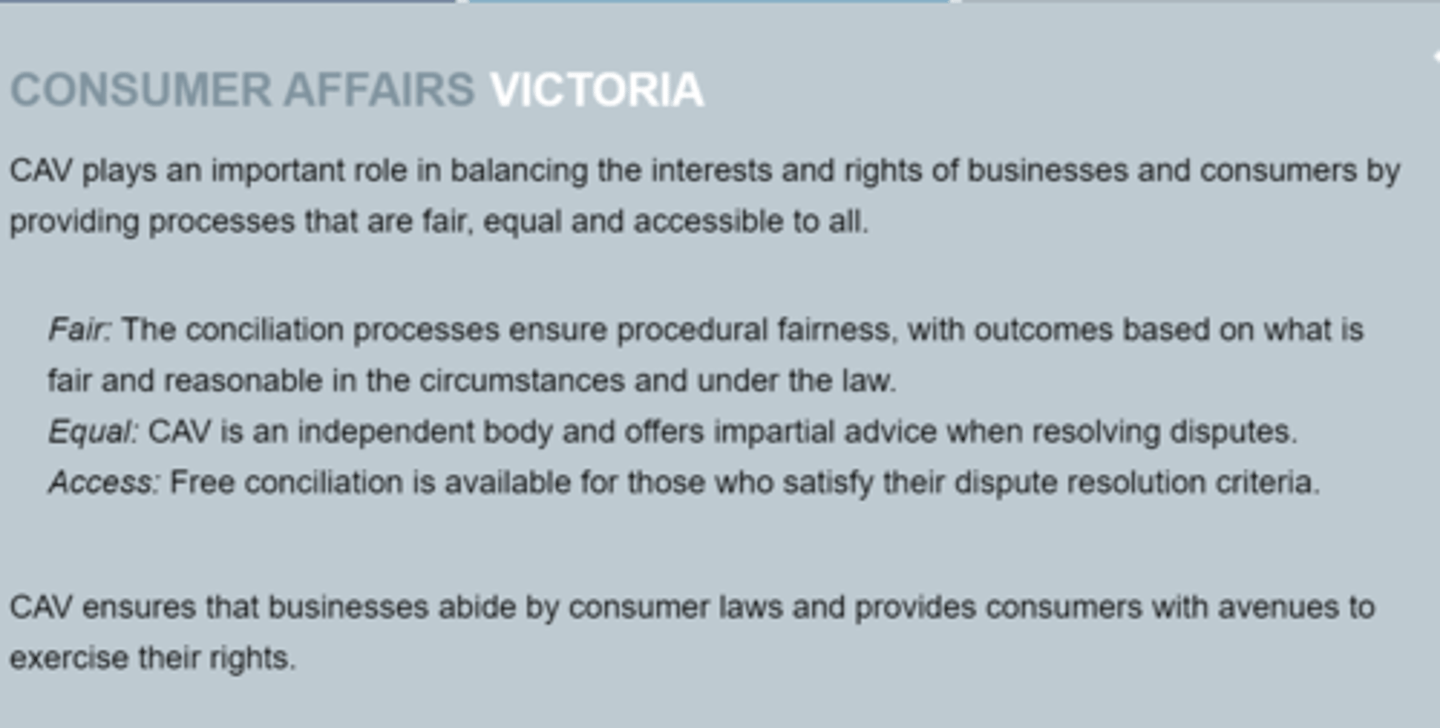
Purpose of Consumer Affairs Victoria (CAV) in resolving civil disputes
- To help people come to an agreement about how to resolve their disputes efficiently without any cost to them
- to try to help the parties reach a resolution that is consistent with the law
They primarily resolve disputes over the phone or in-person conciliation
Appropriateness of Consumer Affairs Victoria
- Whether the dispute is within CAVs jurisdiction
- whether the consumer or tenant has tried to resolve the dispute themselves first
- whether the complaint justifies or needs CAV's involvement
- Whether there has been a breach of legislation or a failure to comply with legal obligations by the landlord or business
- whether the issue has already been dealt with by CAV, the courts or VCAT
- Whether the dispute is likely to be resolved.
CAV's jurisdiction
- The supply of goods and services ($40,000 or less)
- Residential Tenancies
- Retirement villages
- Owners corporations
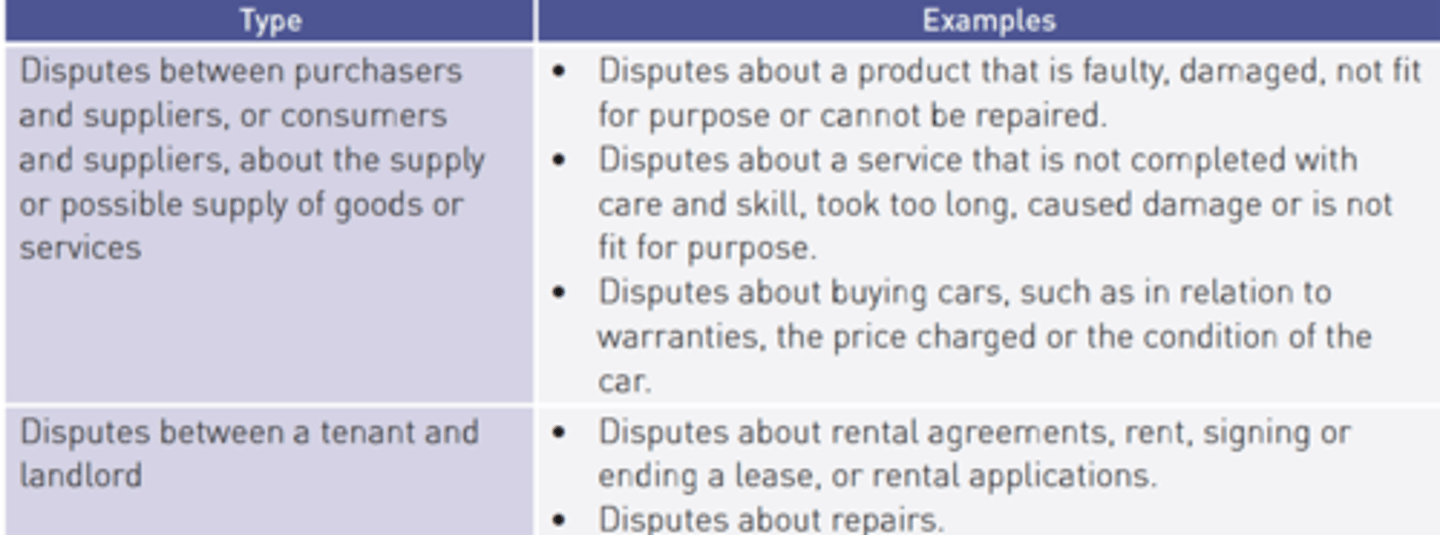
Ability to settle
- There has been no delay in the person complaining to CAV
- CAV's database of complaints doesn't show that the other party has previously refused to participate in conciliation
- The person complaining hasn't contributed to the dispute through inappropriate behaviour
- The dispute isn't overly subjective
- The trader hasn't already made a reasonable offer that was rejected by the consumer
Other ways to resolve the dispute
- Tried to resolve the dispute themselves
- Where the dispute is best resolved (court or tribunal)
- If the other party isn't likely to take the conciliation process seriously.
- If one party would prefer the formality of the tribunal or court processes
- Whether the matter is too big or complex to be appropriate for CAV
- Whether resolution of the matter is urgent, if so, the court is the better resolution.
Strengths of CAV
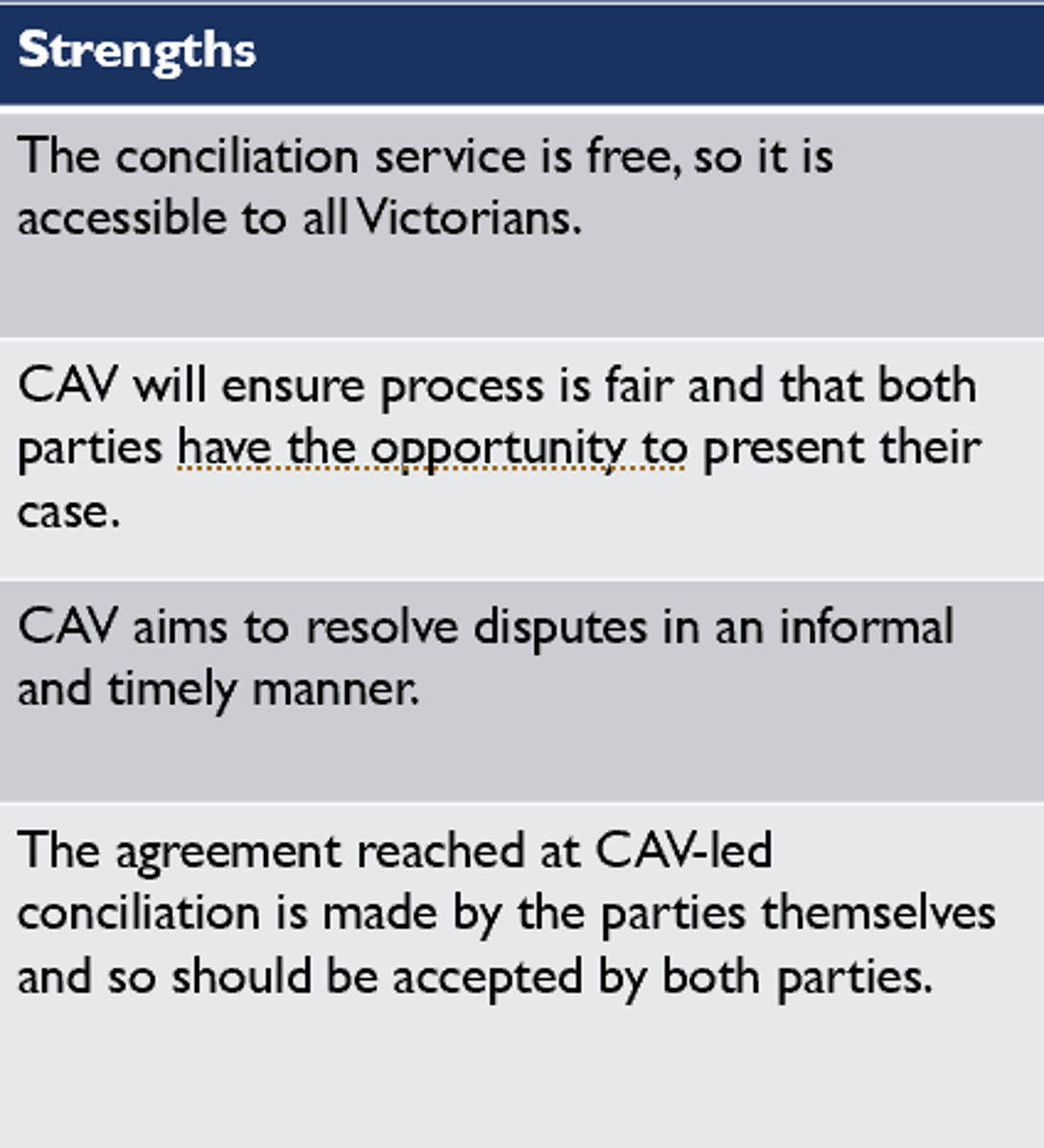
Weaknesses of CAV
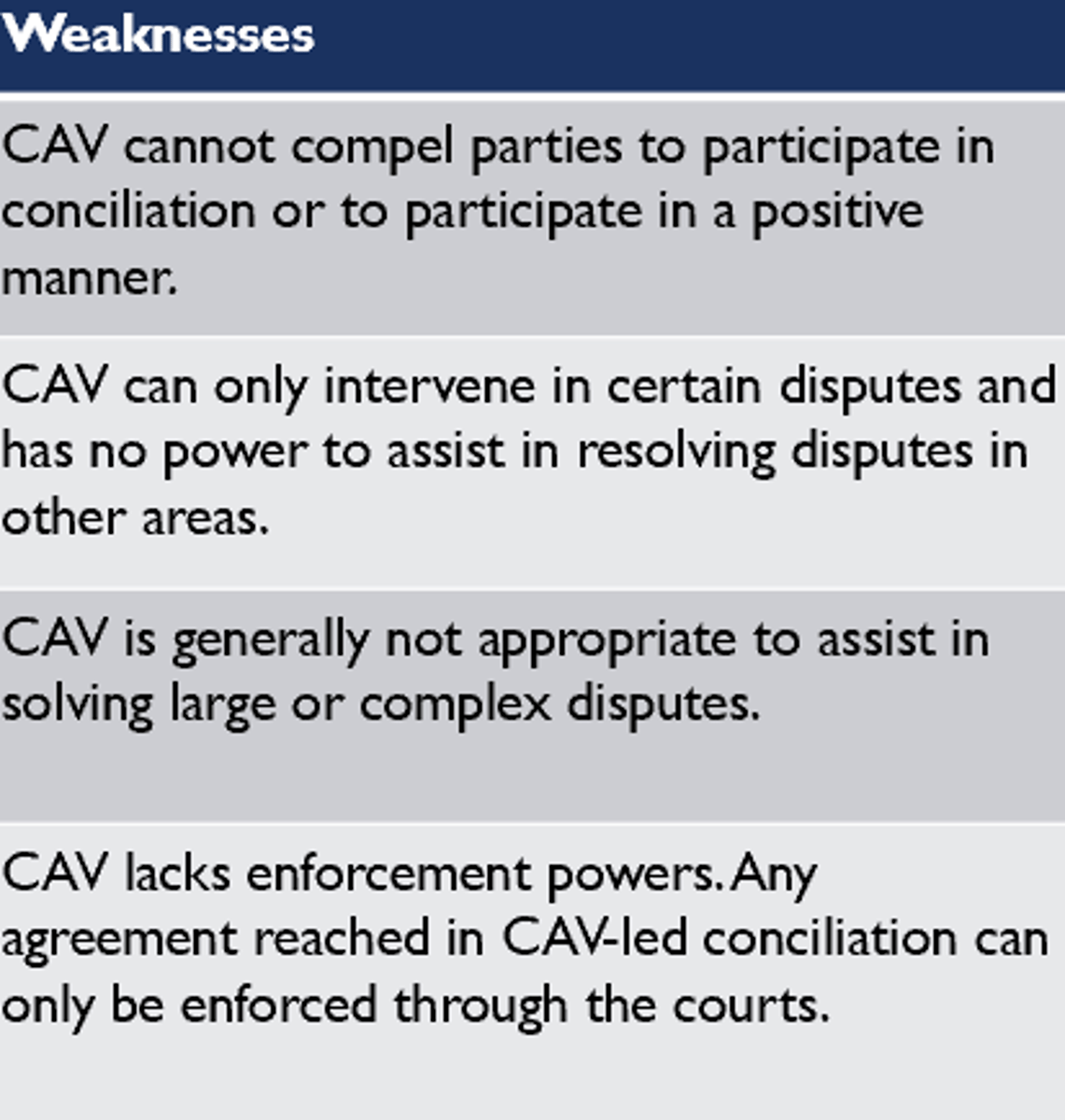
The Victorian Civil and Administrative Tribunal (VCAT)
- A tribunal is a dispute resolution body that resolves civil disputes and is inteded to be less costly, more informal, and faster way to resolve disputes than courts.
- VCAT hears and determines a range of civil and administrative cases in Victoria.
- VCAT is divided into five divisions. Each contains one or more lists, which hear certain types of disputes.
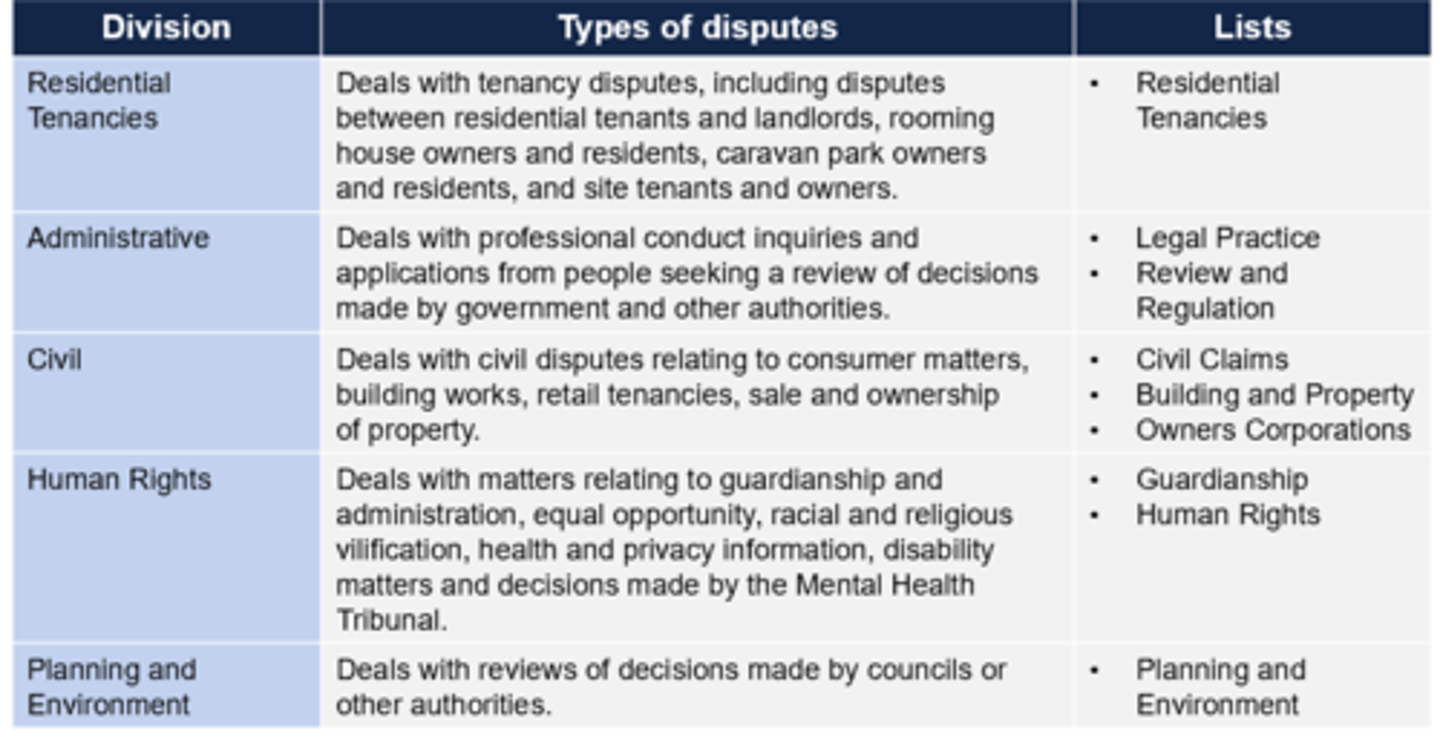
VCAT's jurisdiction
VCAT has exclusive jurisdiction in some matters in which only VCAT has the power to hear, and not a court.
VCAT is not able to hear matters relation to:
•class actions
•disputes between employees and employers
•disputes between neighbours
•disputes between drivers in car accidents
•disputes involving federal or state law where VCAT has not been given any power to hear the matter
•disputes where the parties are residents of different Australian states, or where the Commonwealth is a party.
Purposes of VCAT
- low cost
- Accessible
- Efficient
- Independent
Dispute resolution methods used at VCAT: Mediation
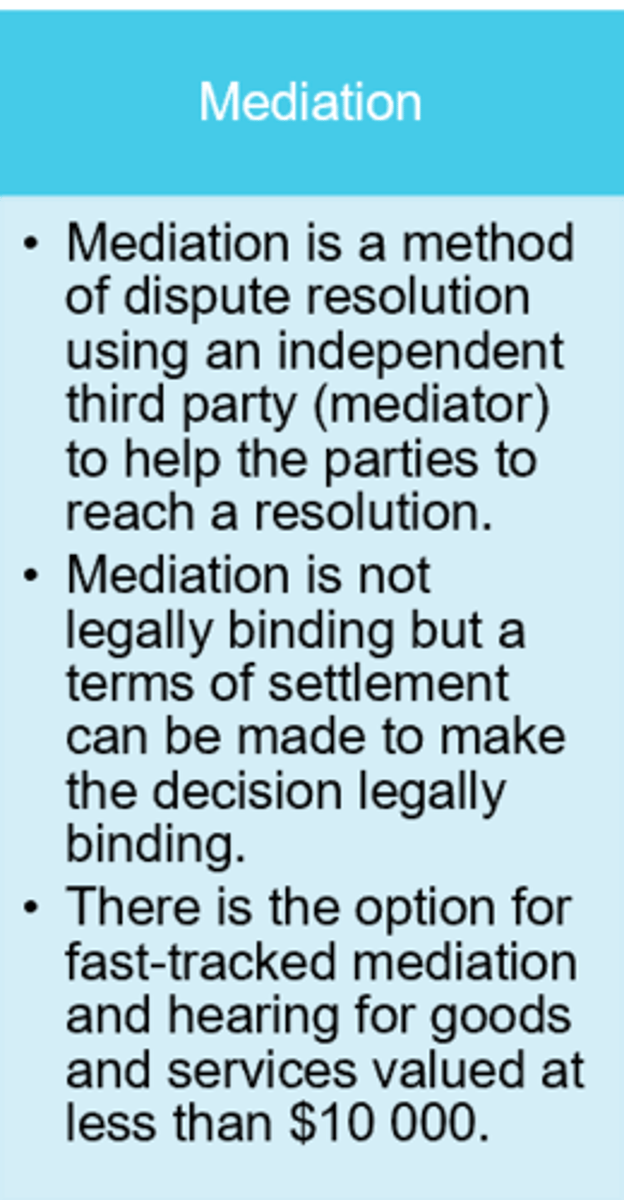
Dispute resolution methods used at VCAT: Compulsory conferences

Dispute resolution methods used at VCAT: Final hearing
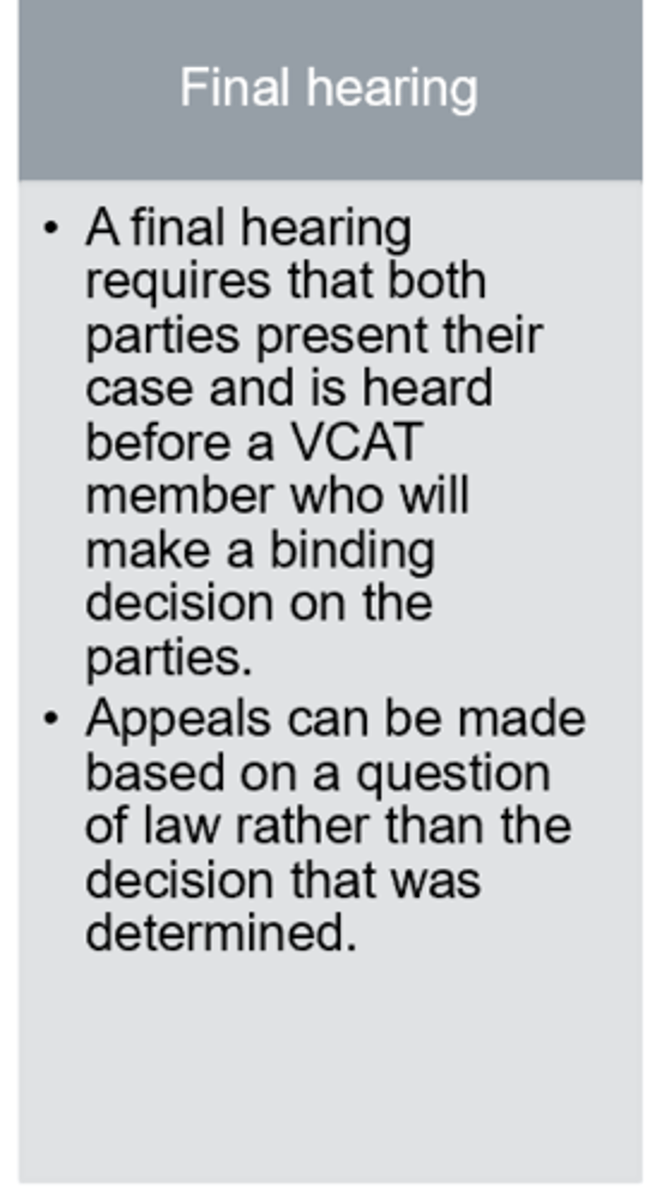
VCAT orders
- Require a party to pay money
- Require a party to do something, such as perform work, carry out repairs, or vacate premises
- Require a party to refrain from doing something
- Declare that a debt is or is not owing
- Review, vary, or cancel a contract
- Dismiss a claim
Exclusive jurisdiction
the lawful authority or power of a court, tribunal or other dispute resolution body to decide legal cases to the exclusion of all others (often parties must take their dispute to VCAT because of this - they have exclusive jurisdiction to hear certain types of claims)
Fast track mediation and hearing (FMAH)
A dispute resolution process used for small claims about goods and services in Civil Claims List at the Victorian Civil and Administrative Tribunal. Both the mediation and the hearing will normally be conducted on the same day (if the dispute is not settled in mediation)
Compulsory conference
A confidential meeting between the parties involved in a dispute (in the presence of an independent third party) to discuss ways to resolve their differences and explore possible resolutions.
VCAT appropriateness
- Whether the dispute is within VCAT's jurisdiction
- Whether the parties can resolve the dispute themselves through negotiation or mediation
- The nature of the fees and whether the applicant can pay them
- Whether the parties wish to have greater avenues of appeal
- Whether one or more of the parties are unlikely to take VCAT seriously
- Whether one or more of the parties would prefer the formality of the courtroom
- whether the matter is of a complexity or size that is not appropriate for VCAT
- whether the party prefers to resolve the dispute because of the doctrine of precedent.
Strengths of VCAT

Weaknesses of VCAT
